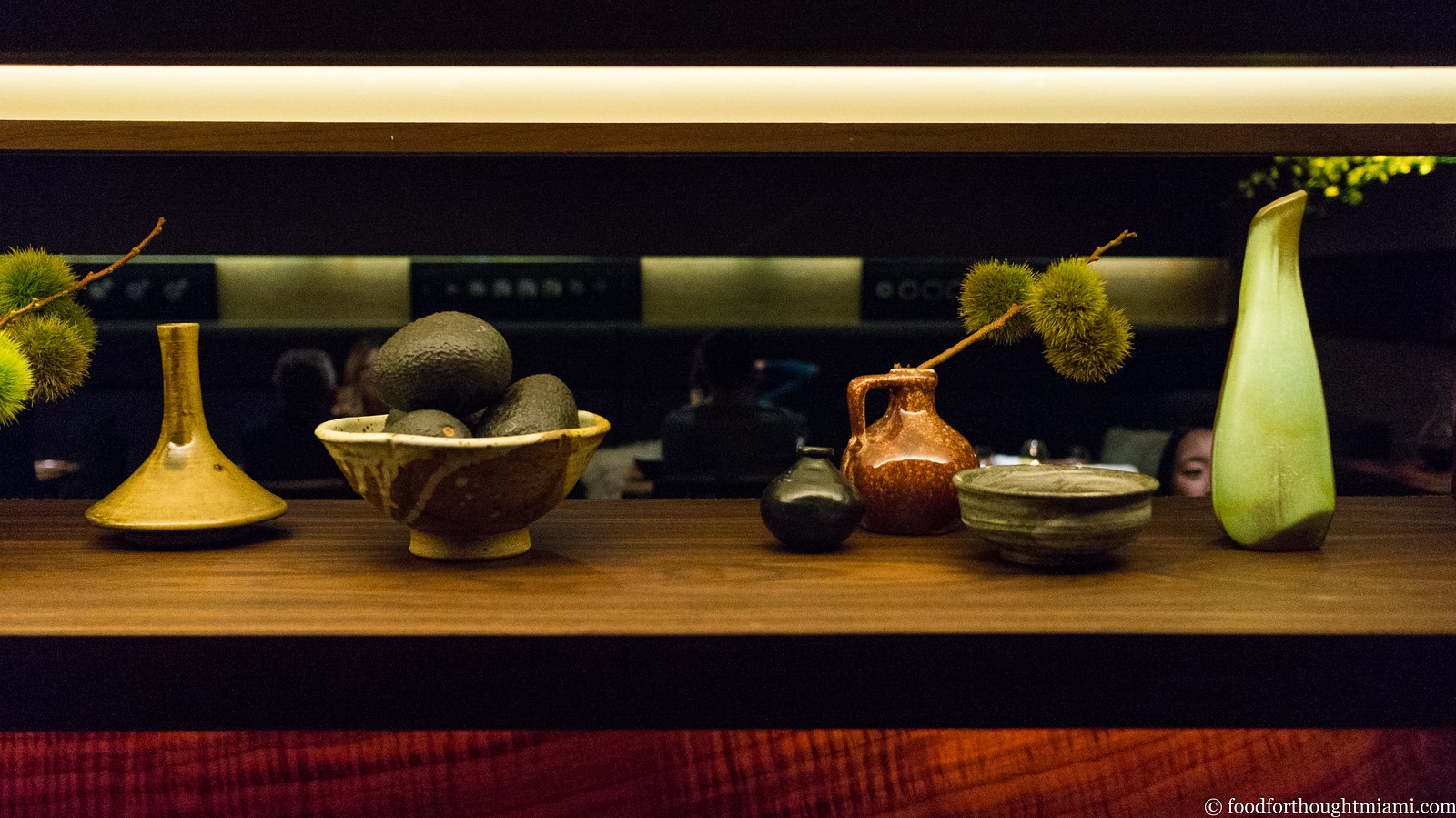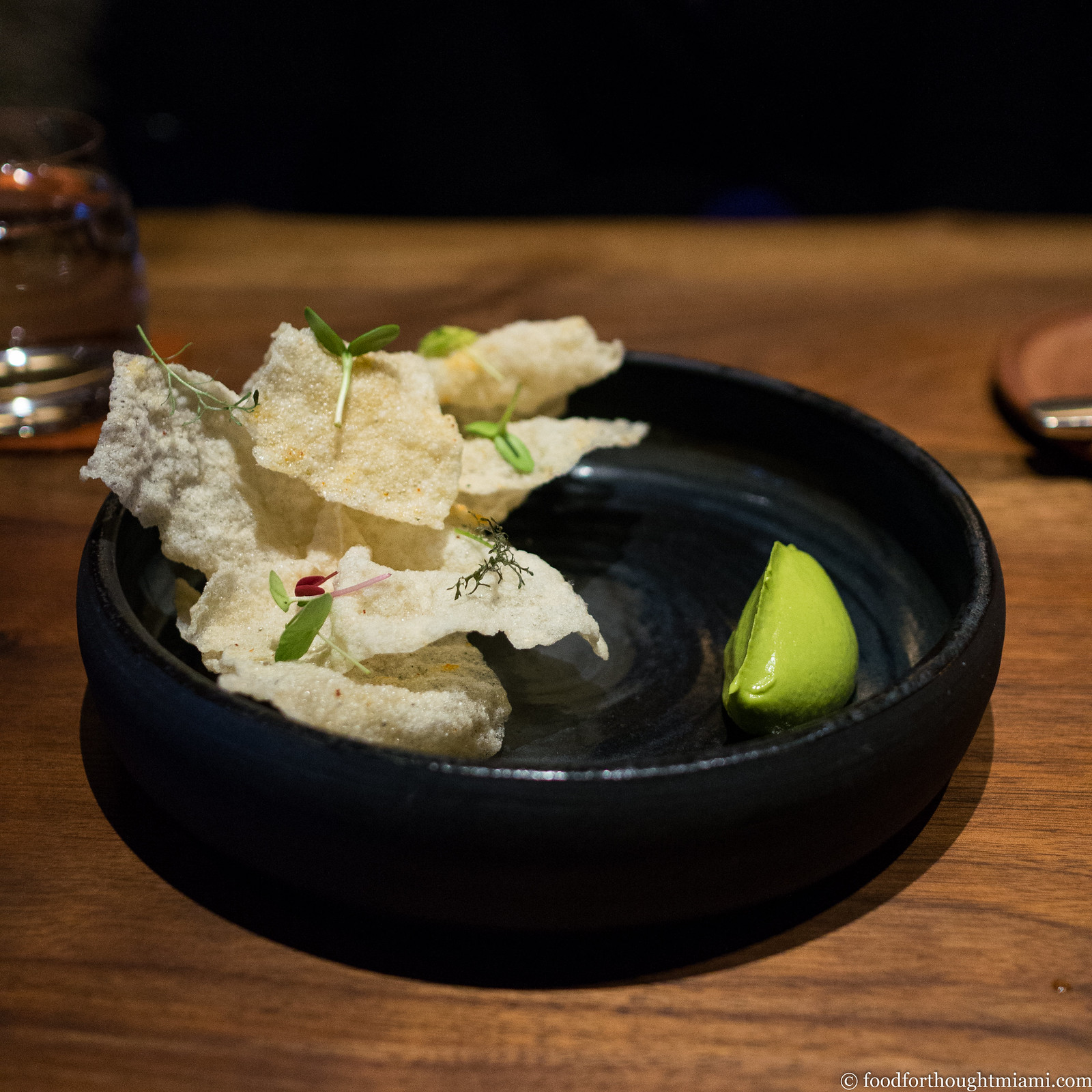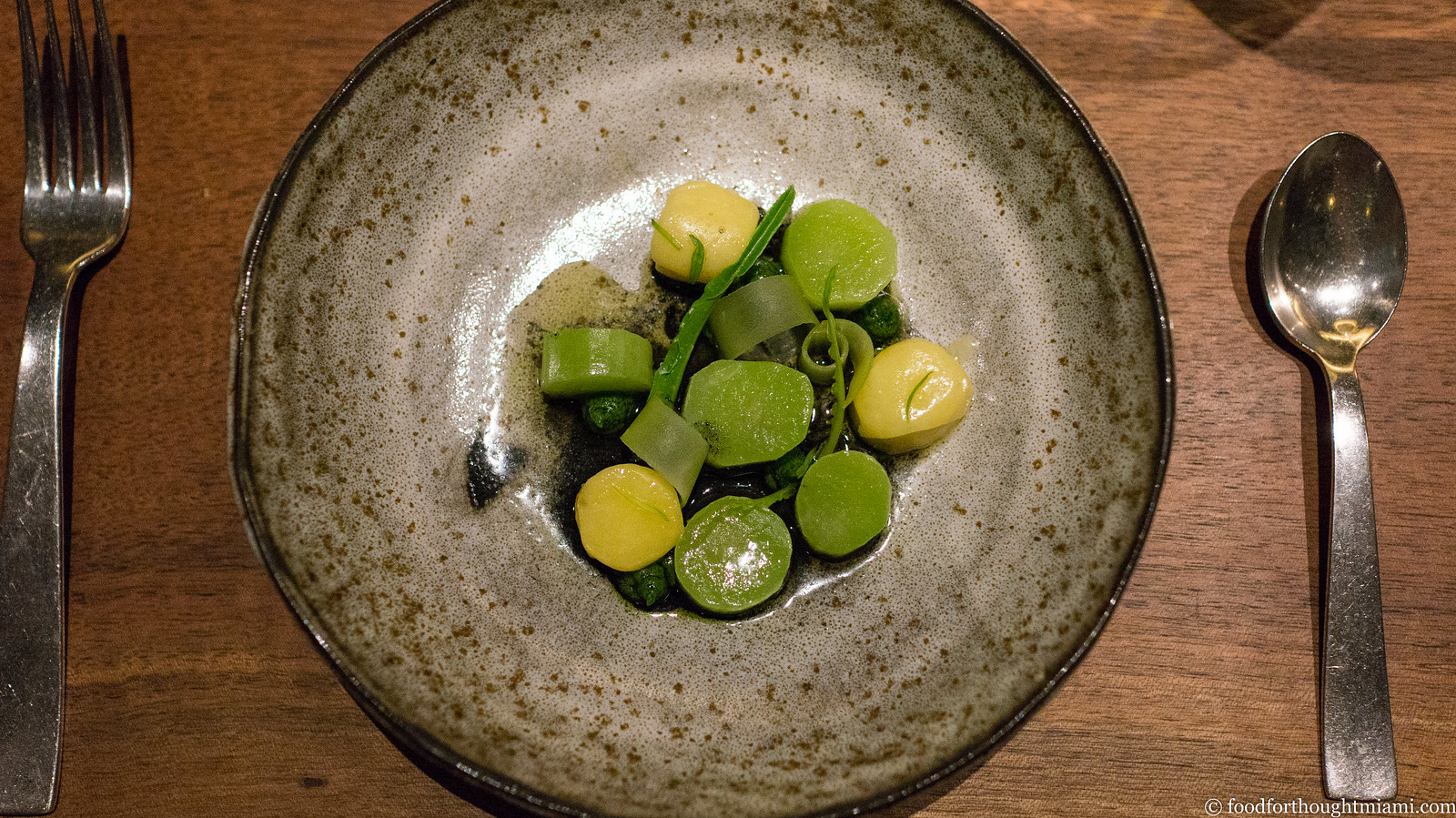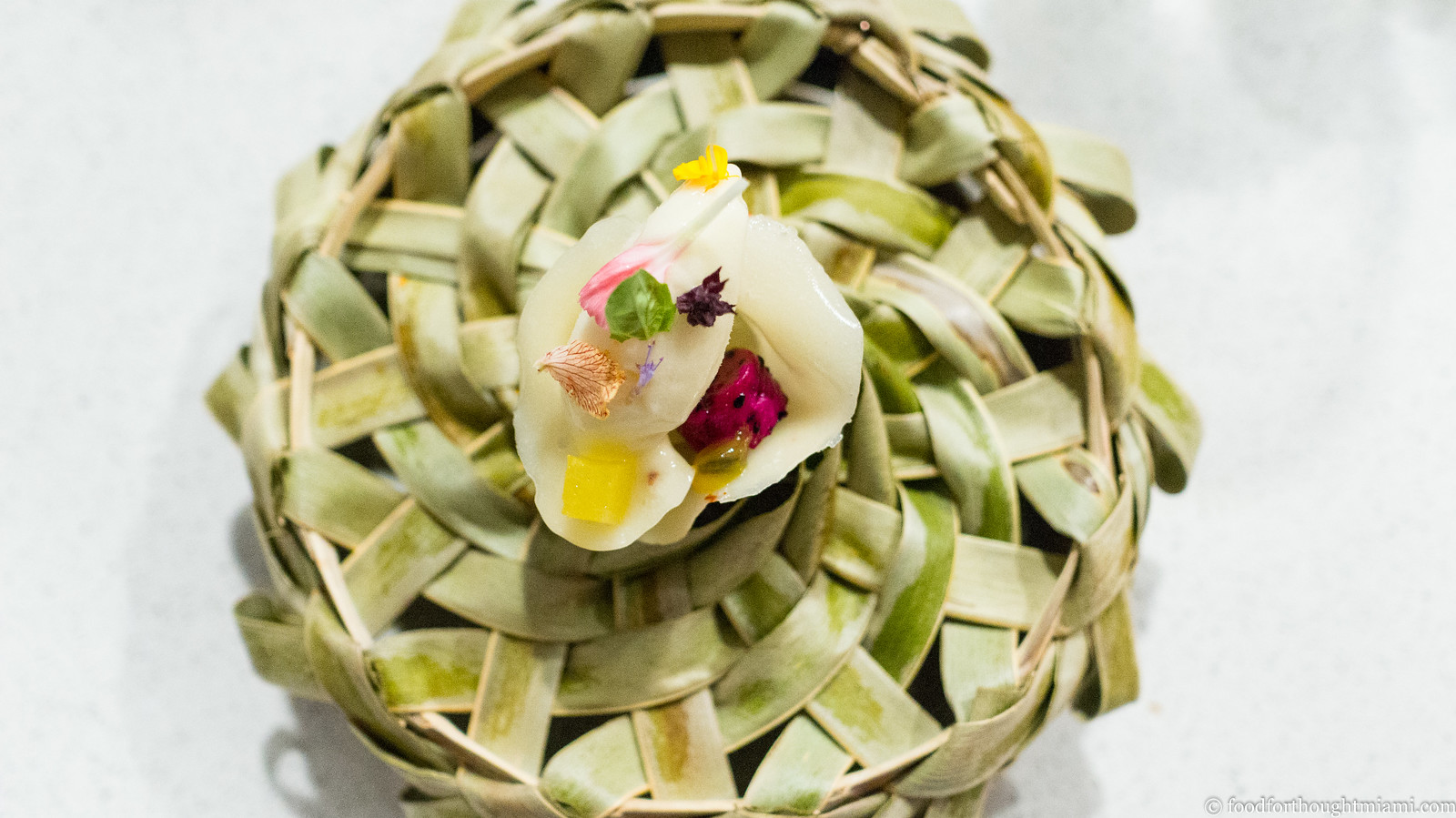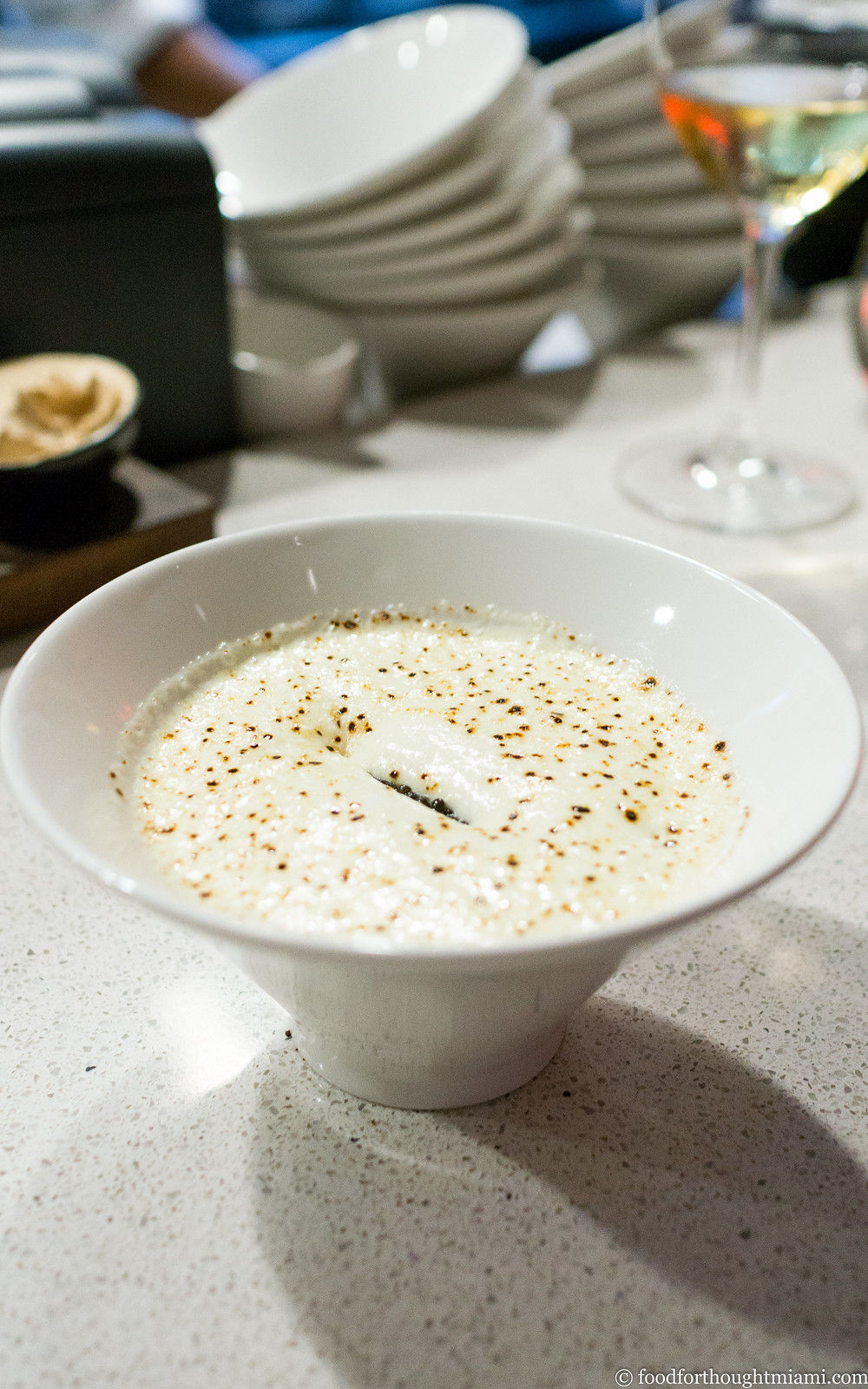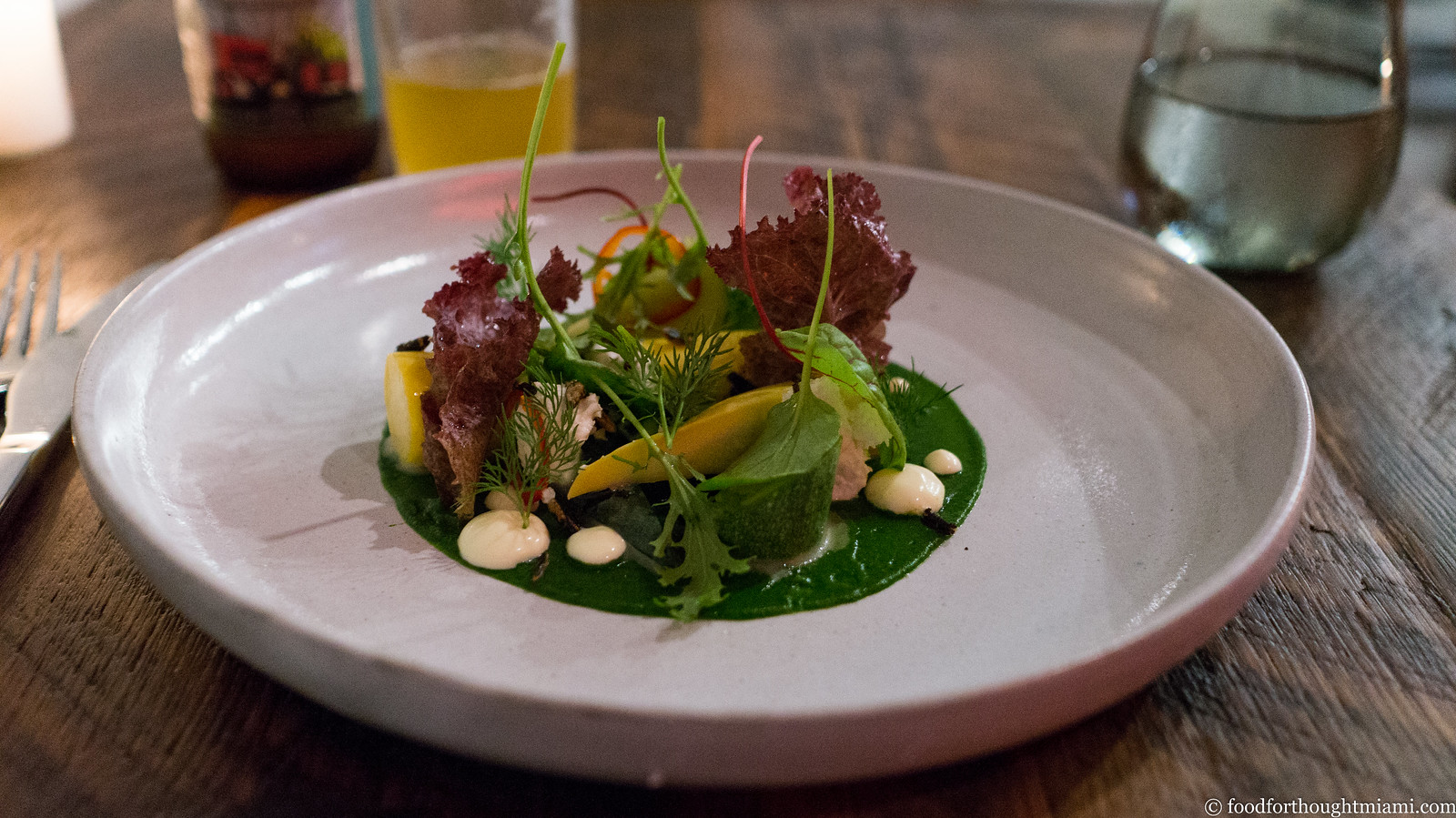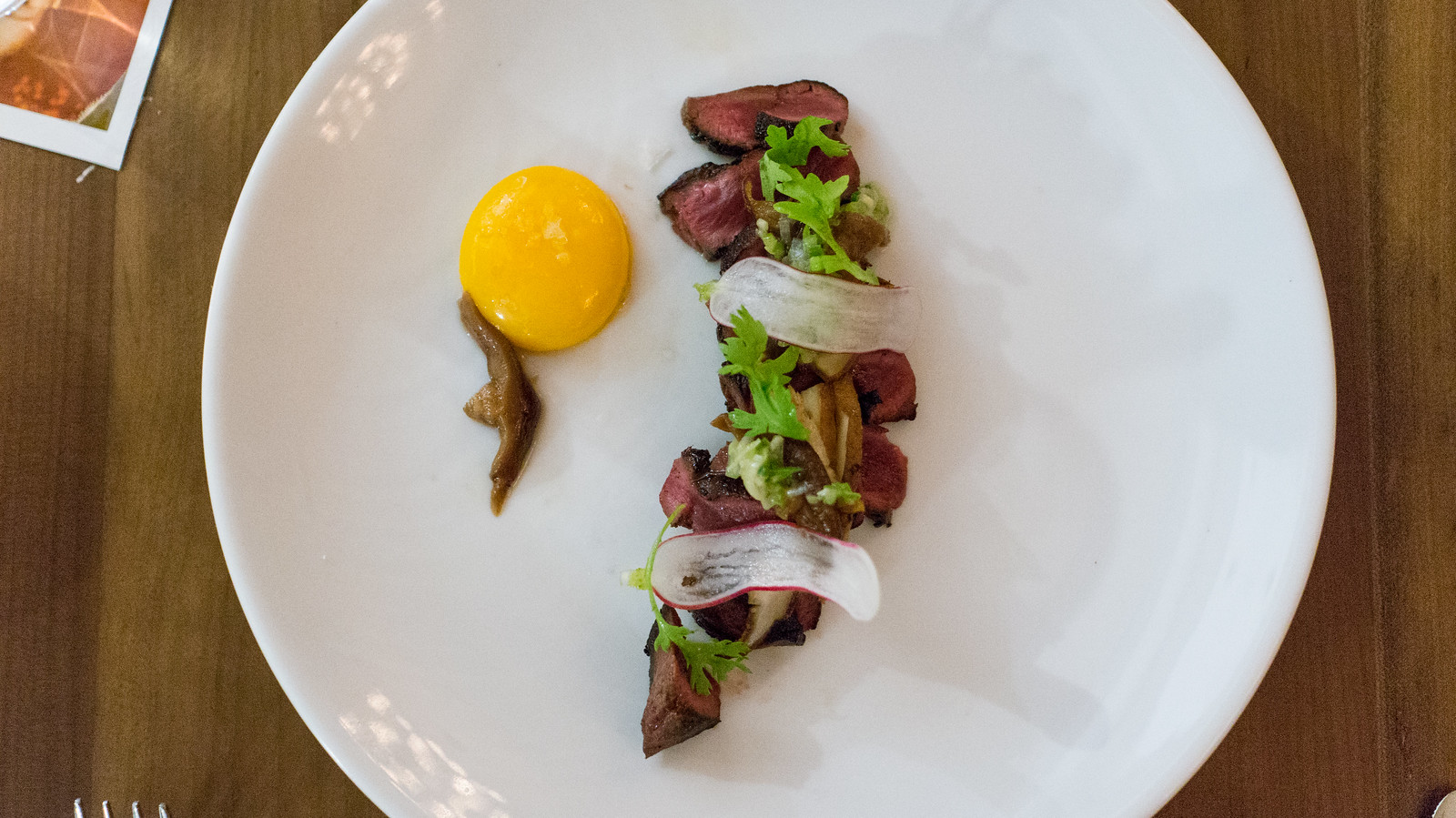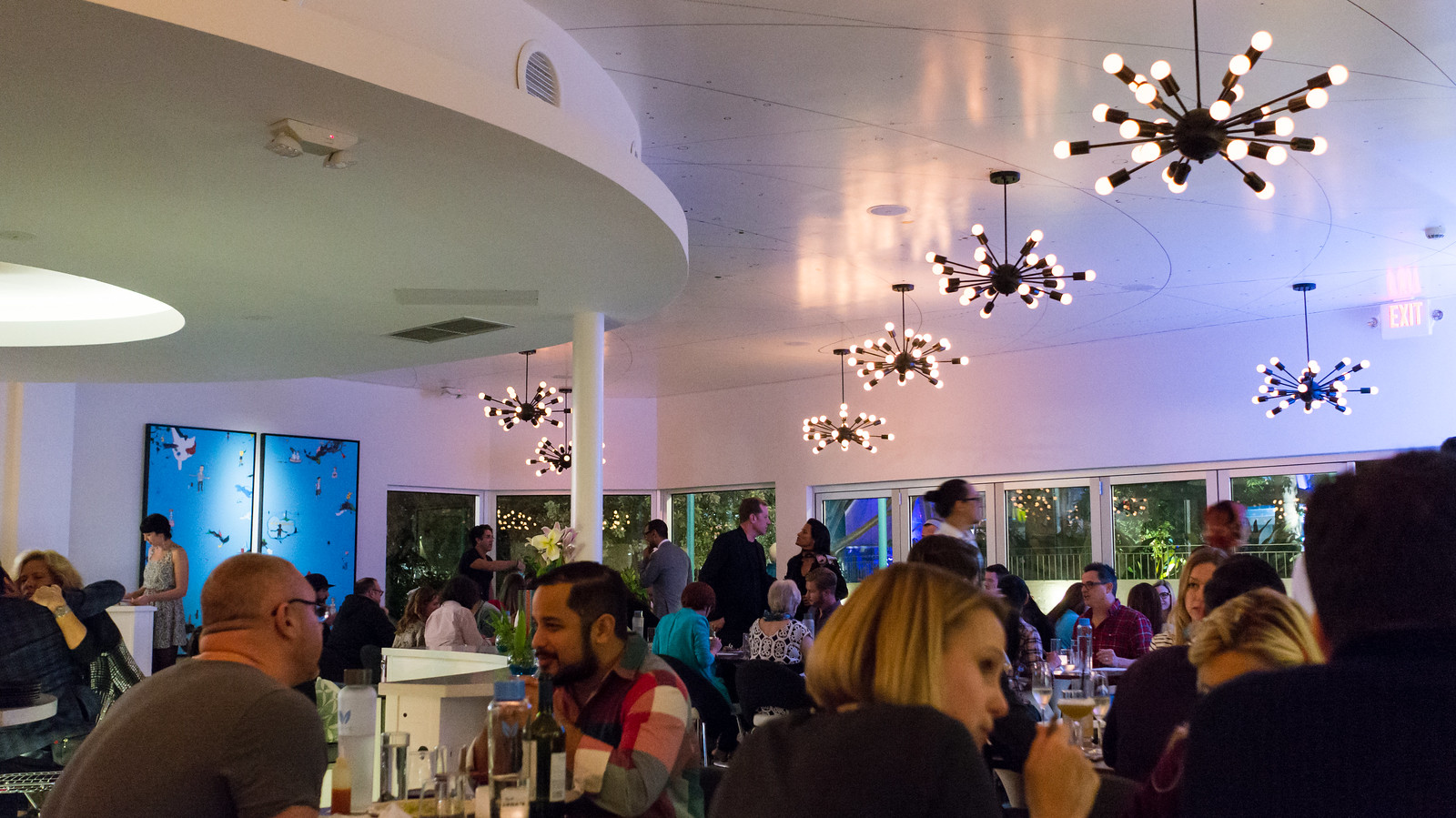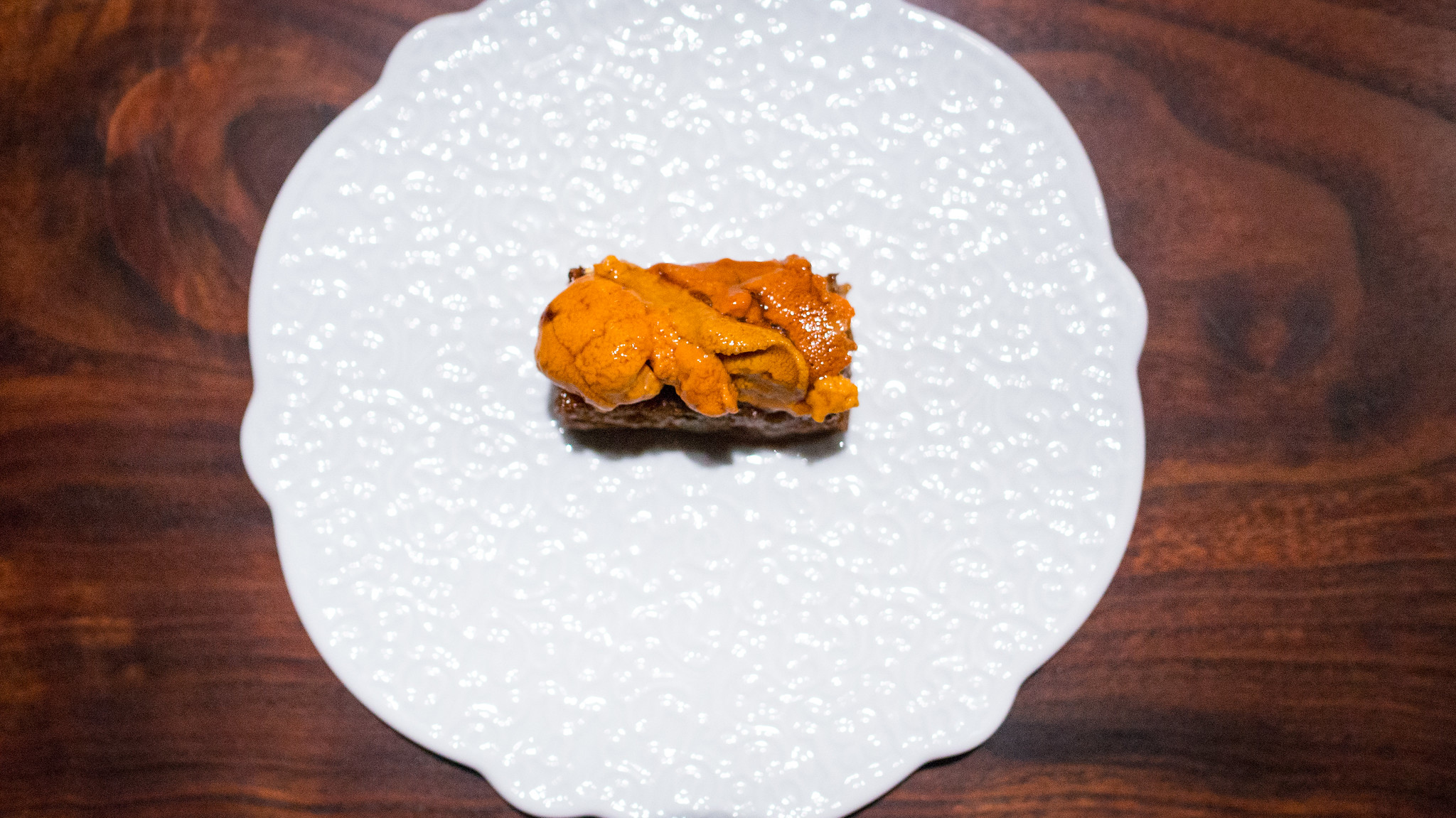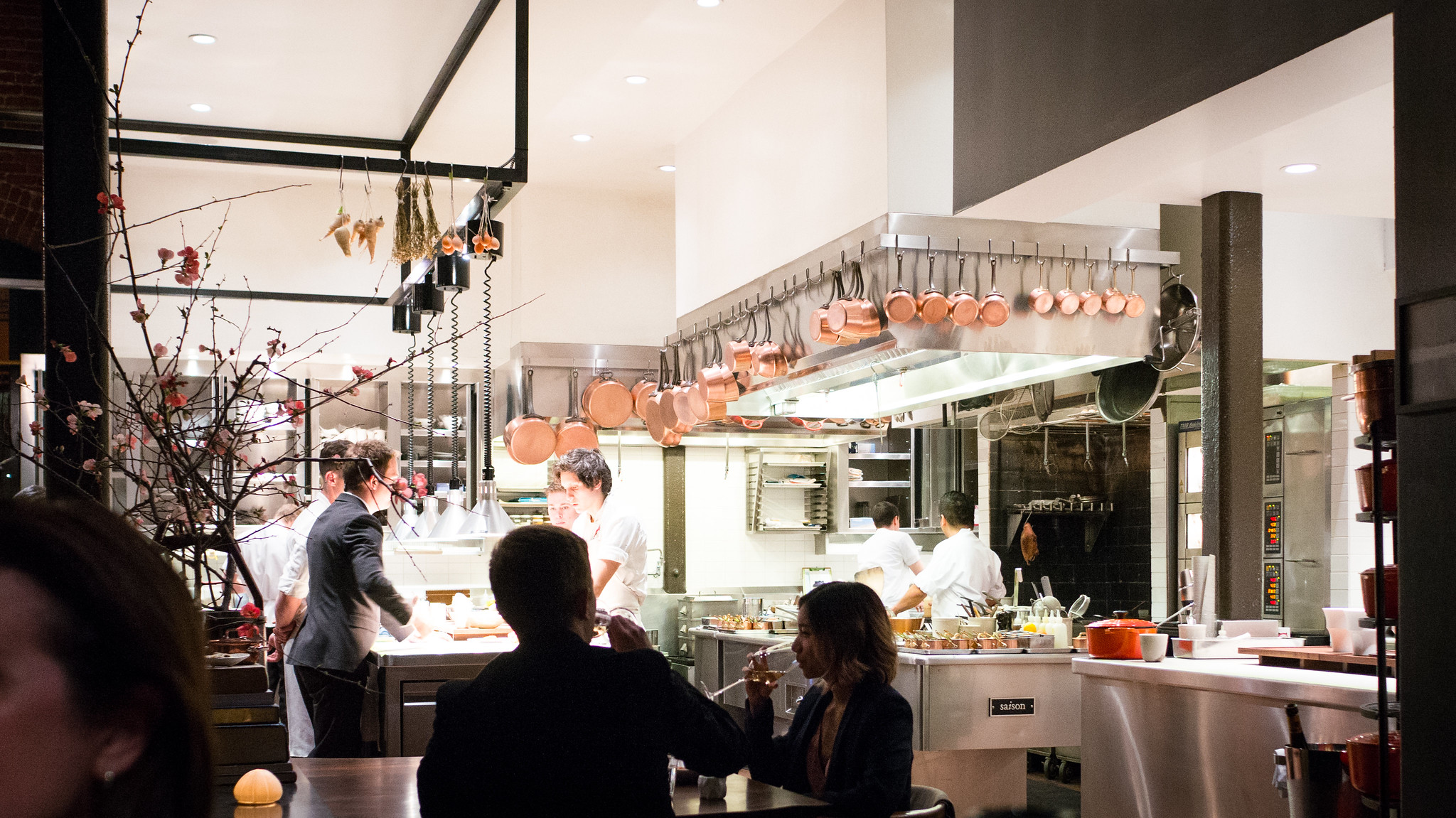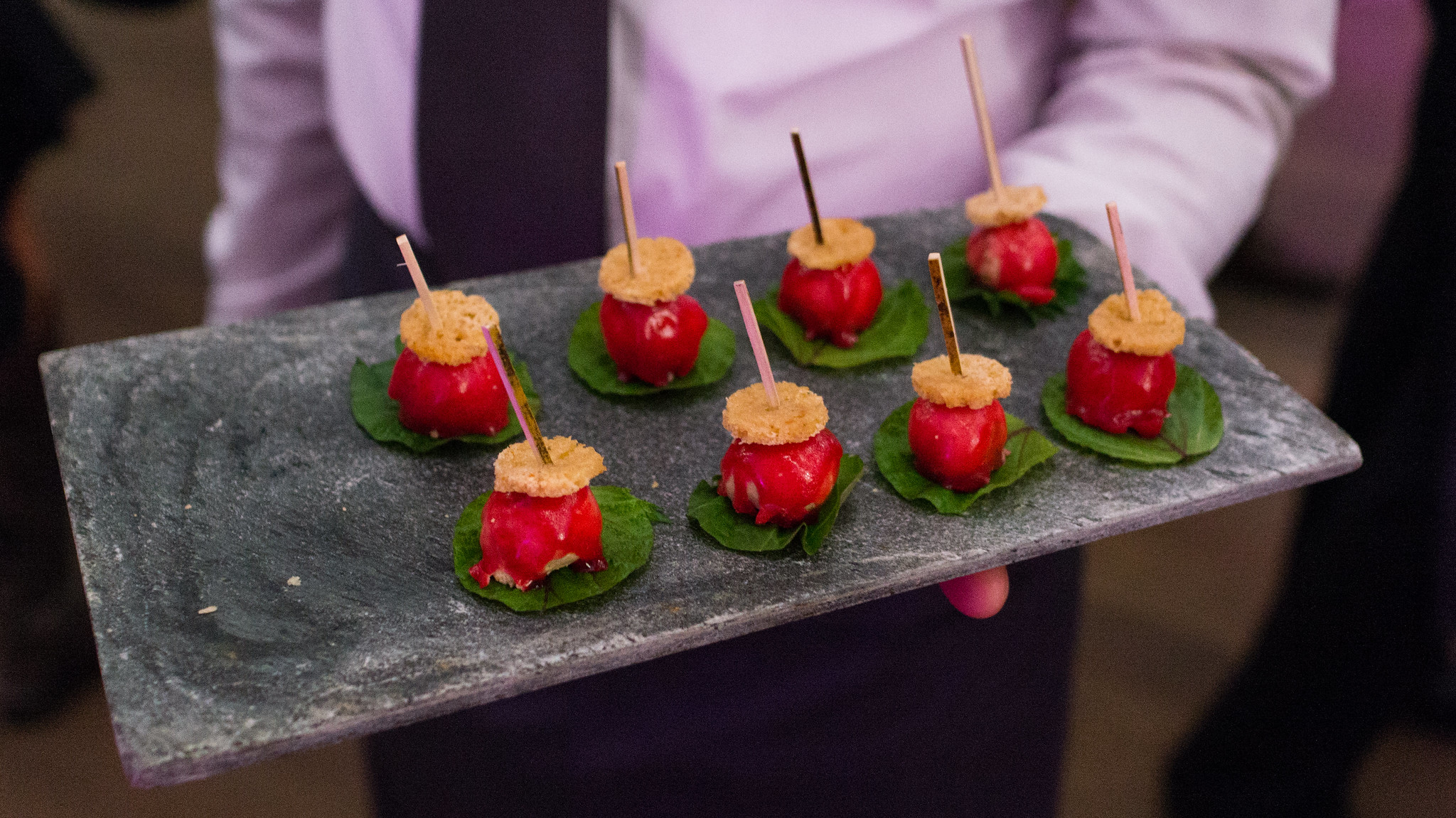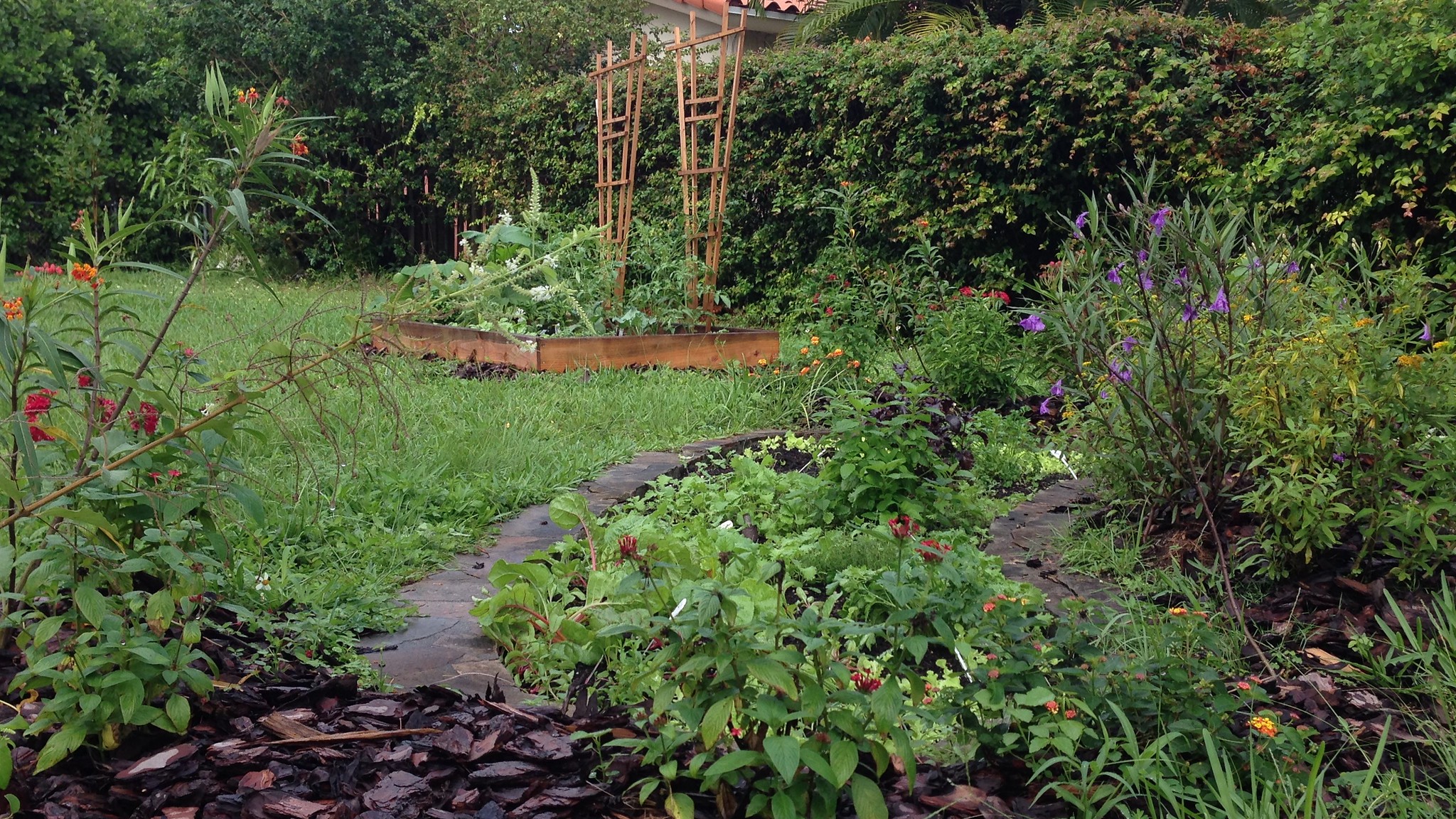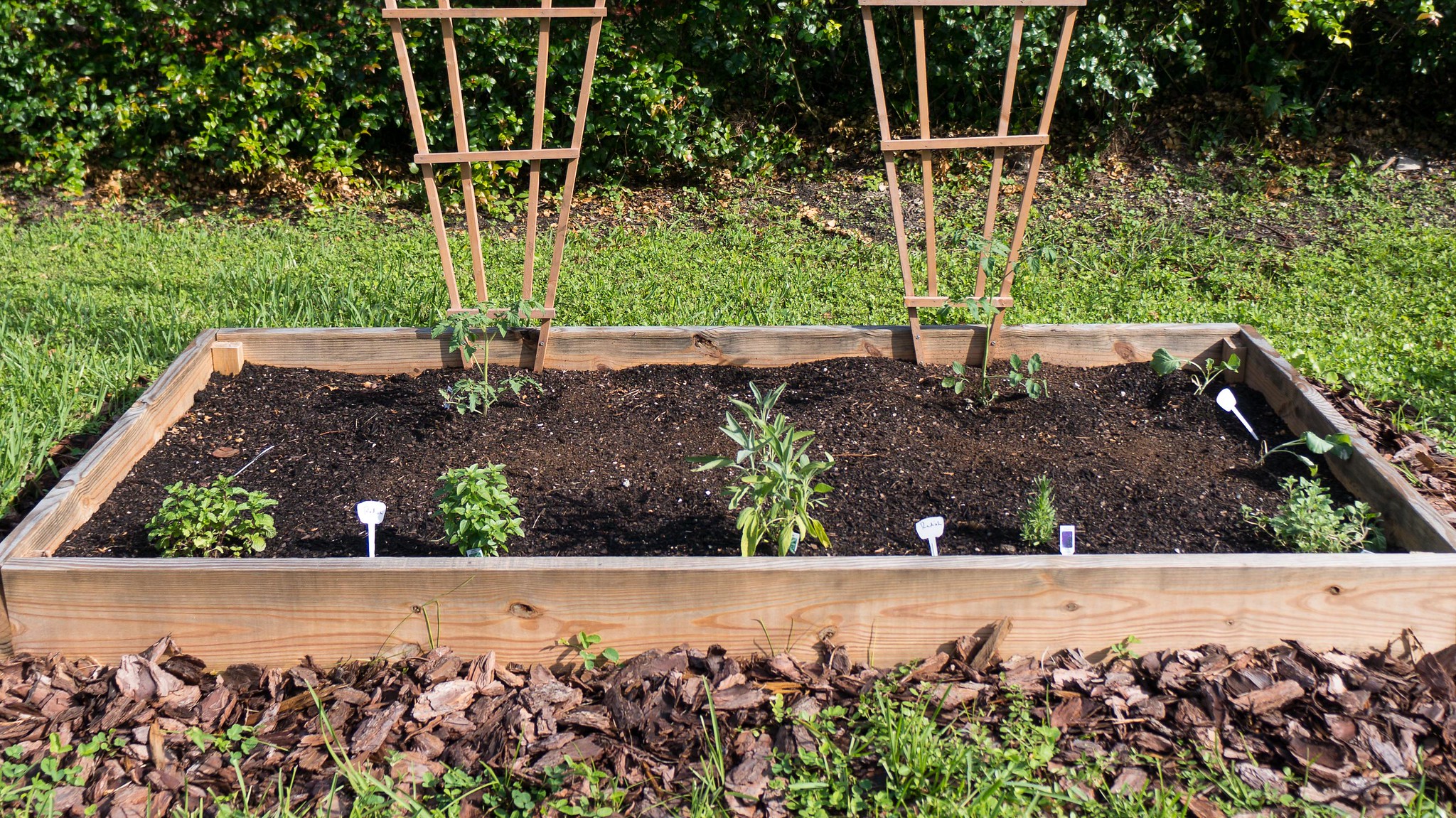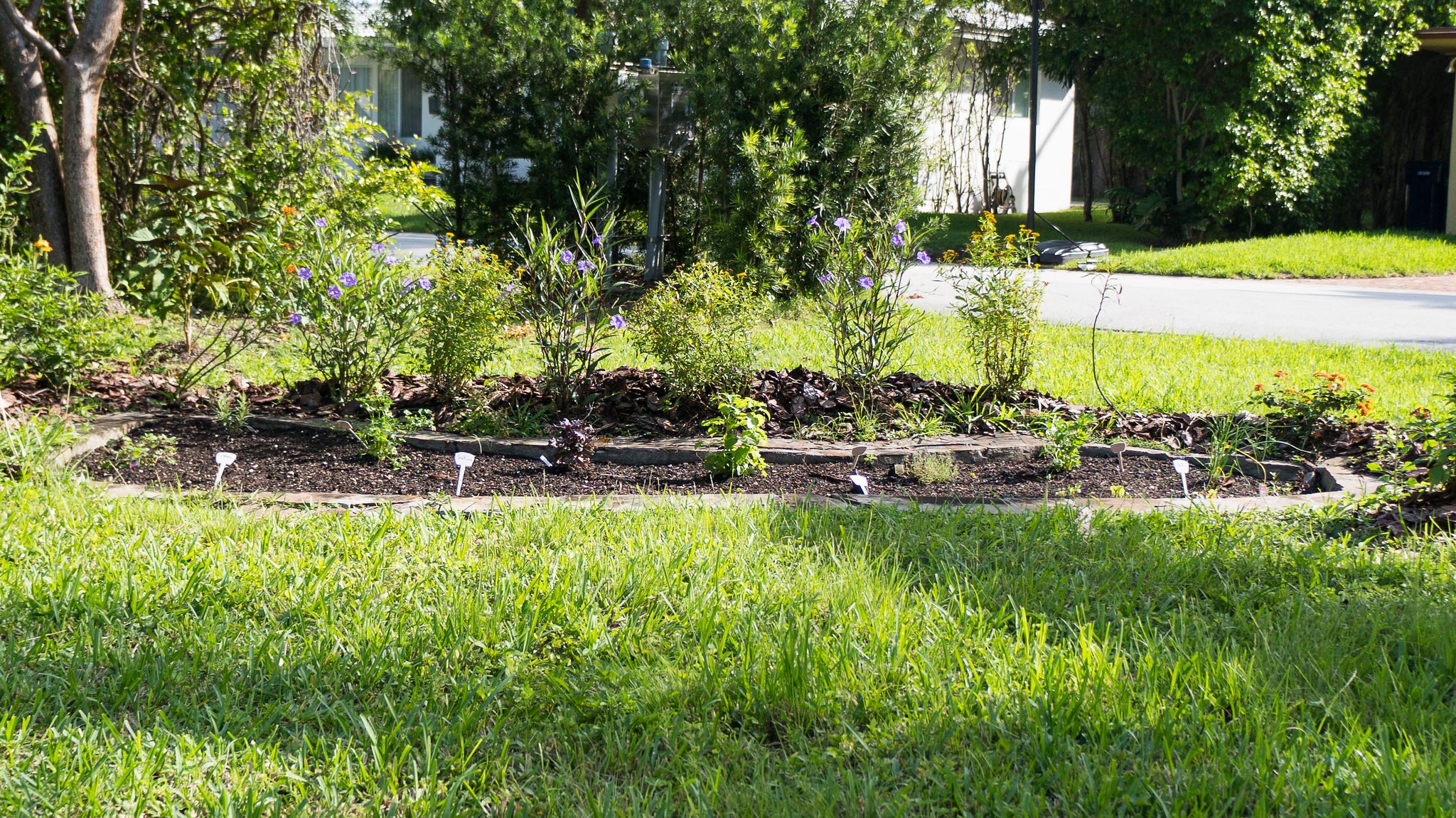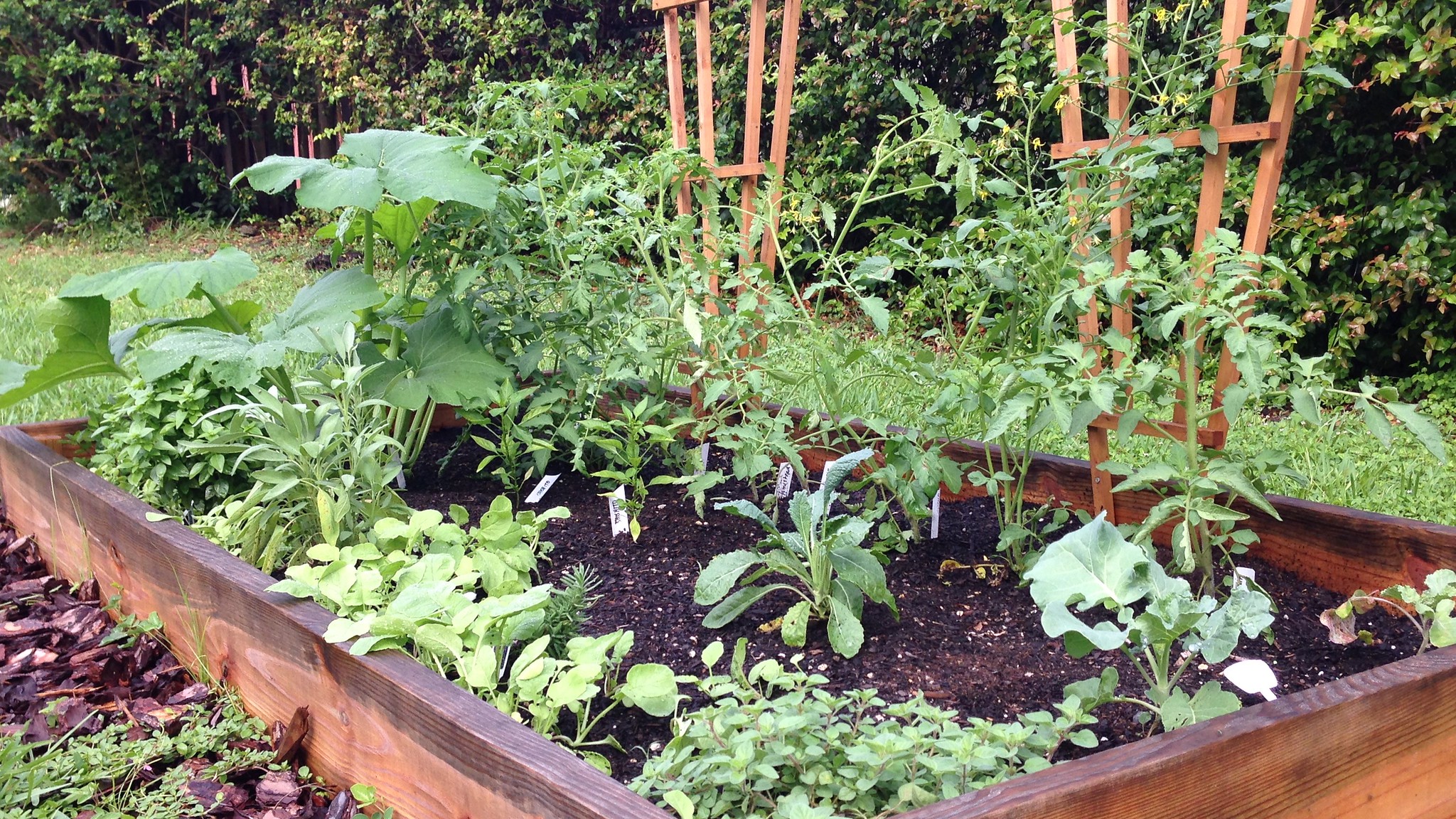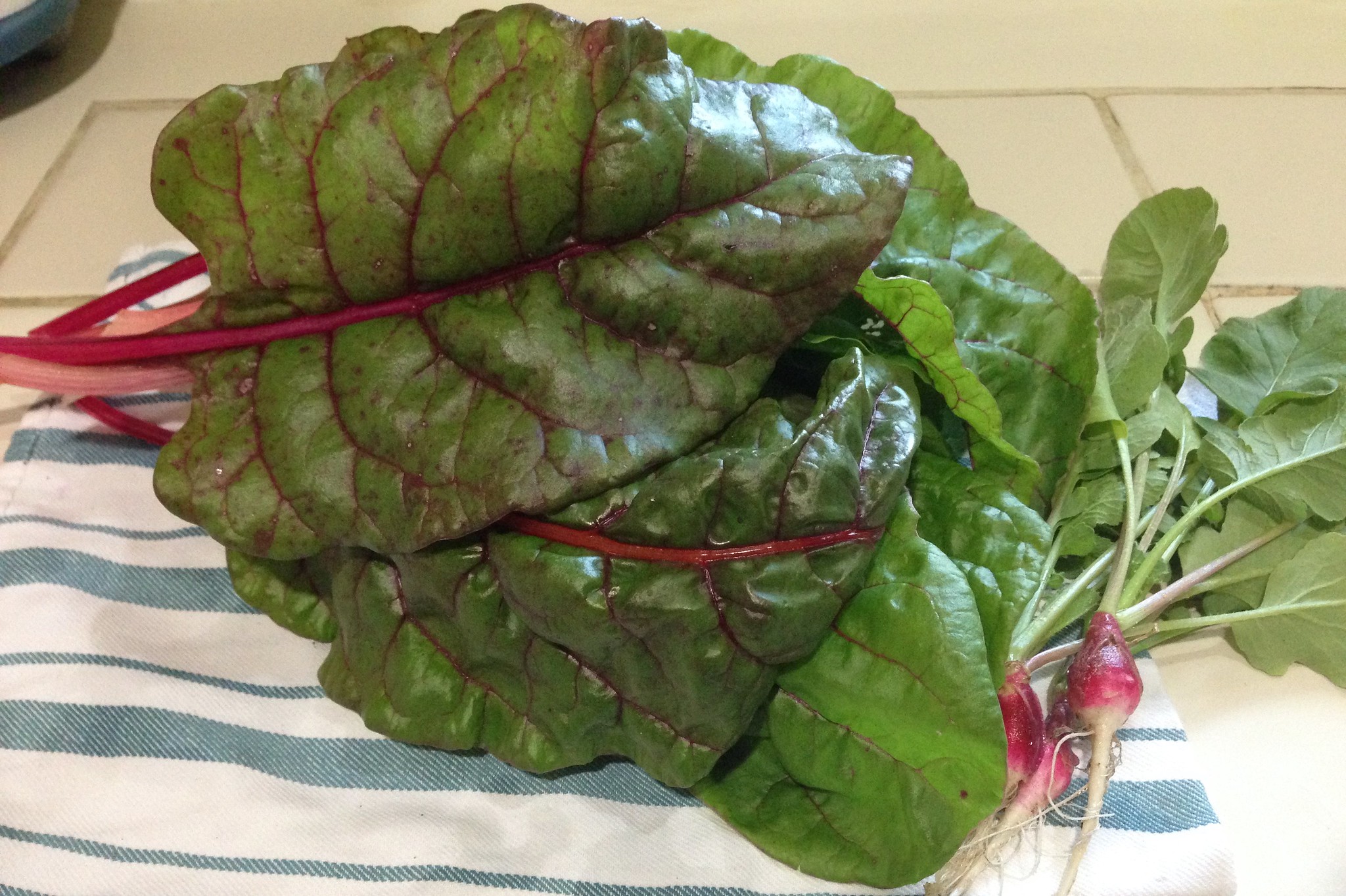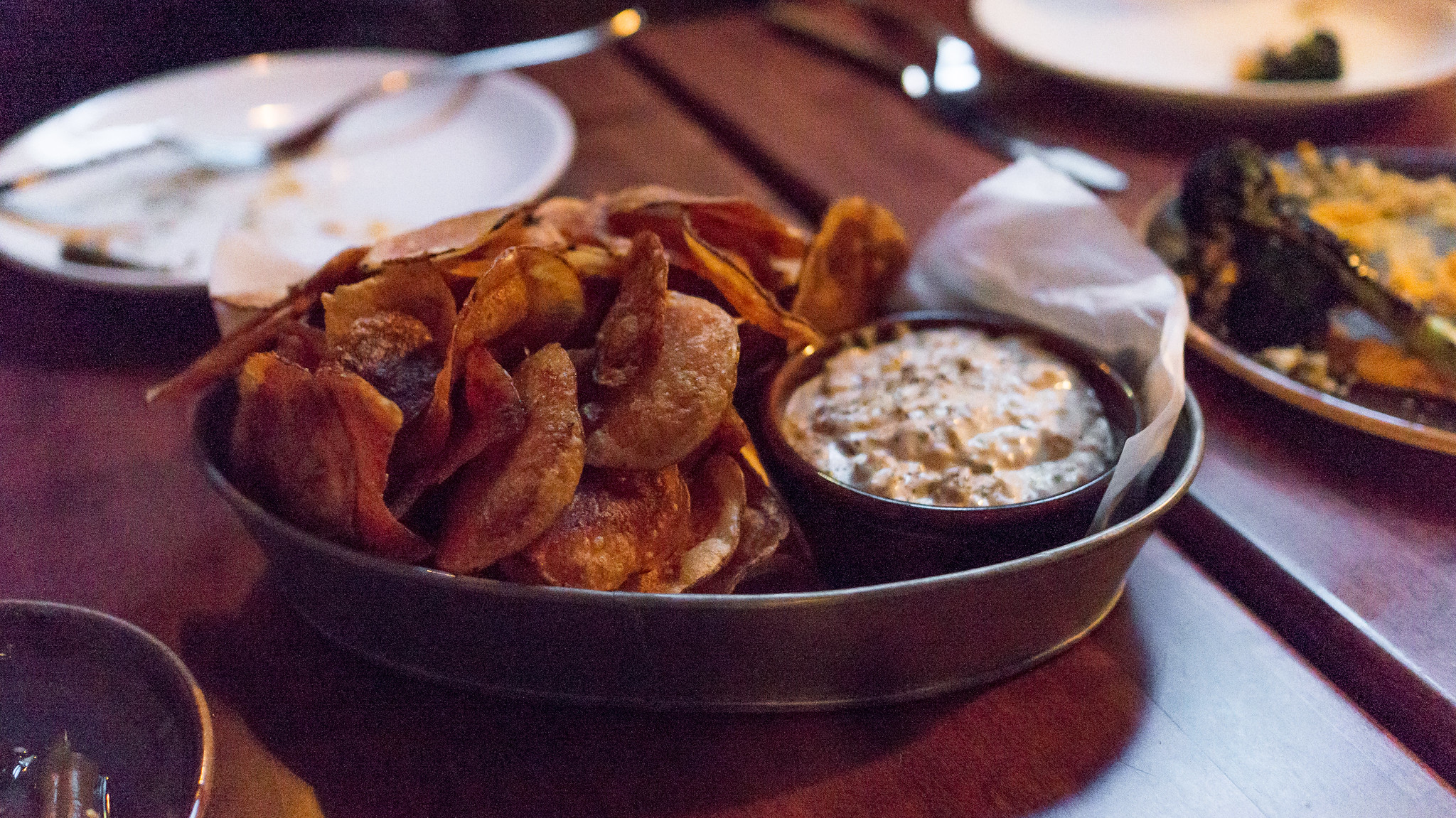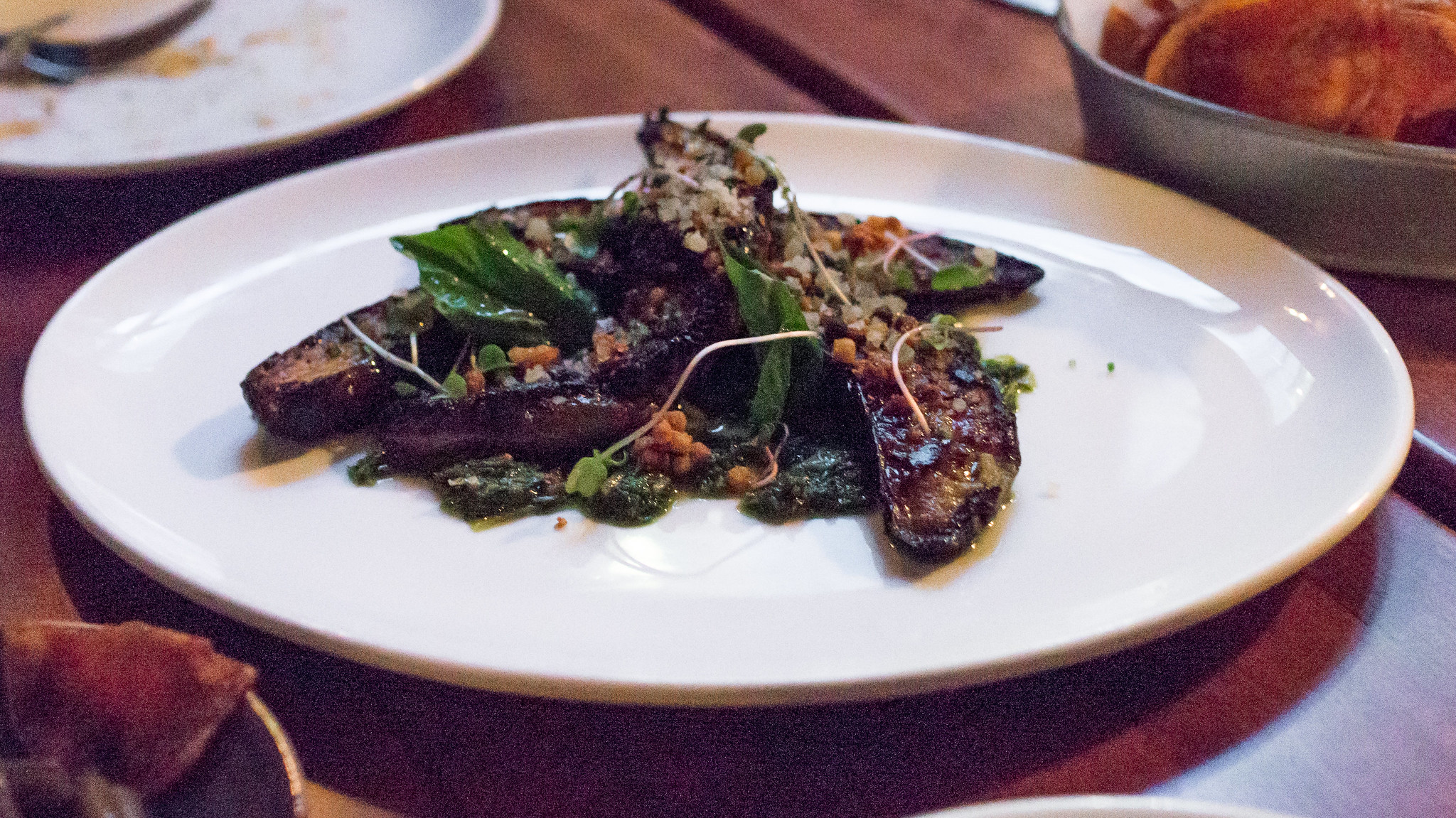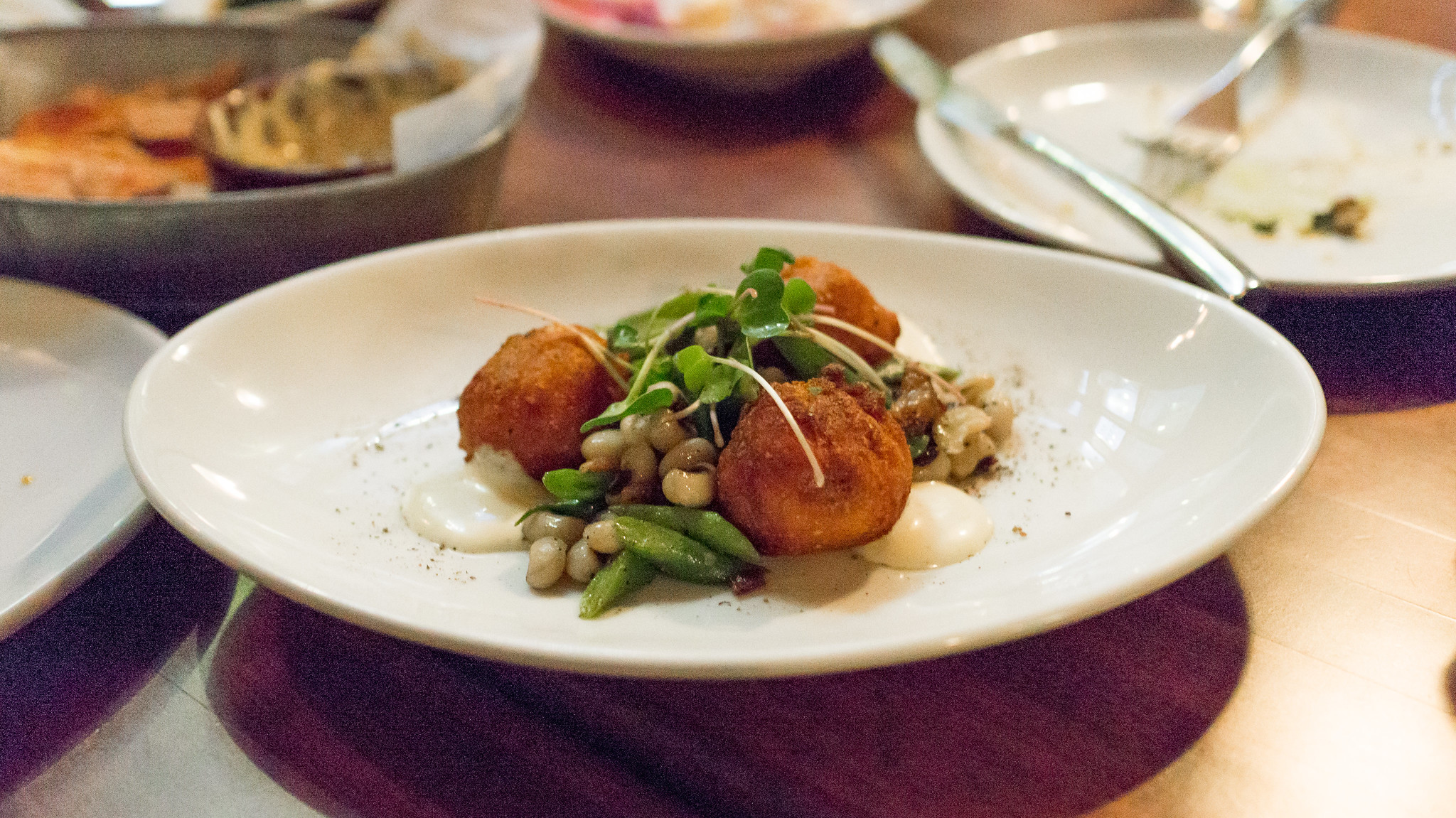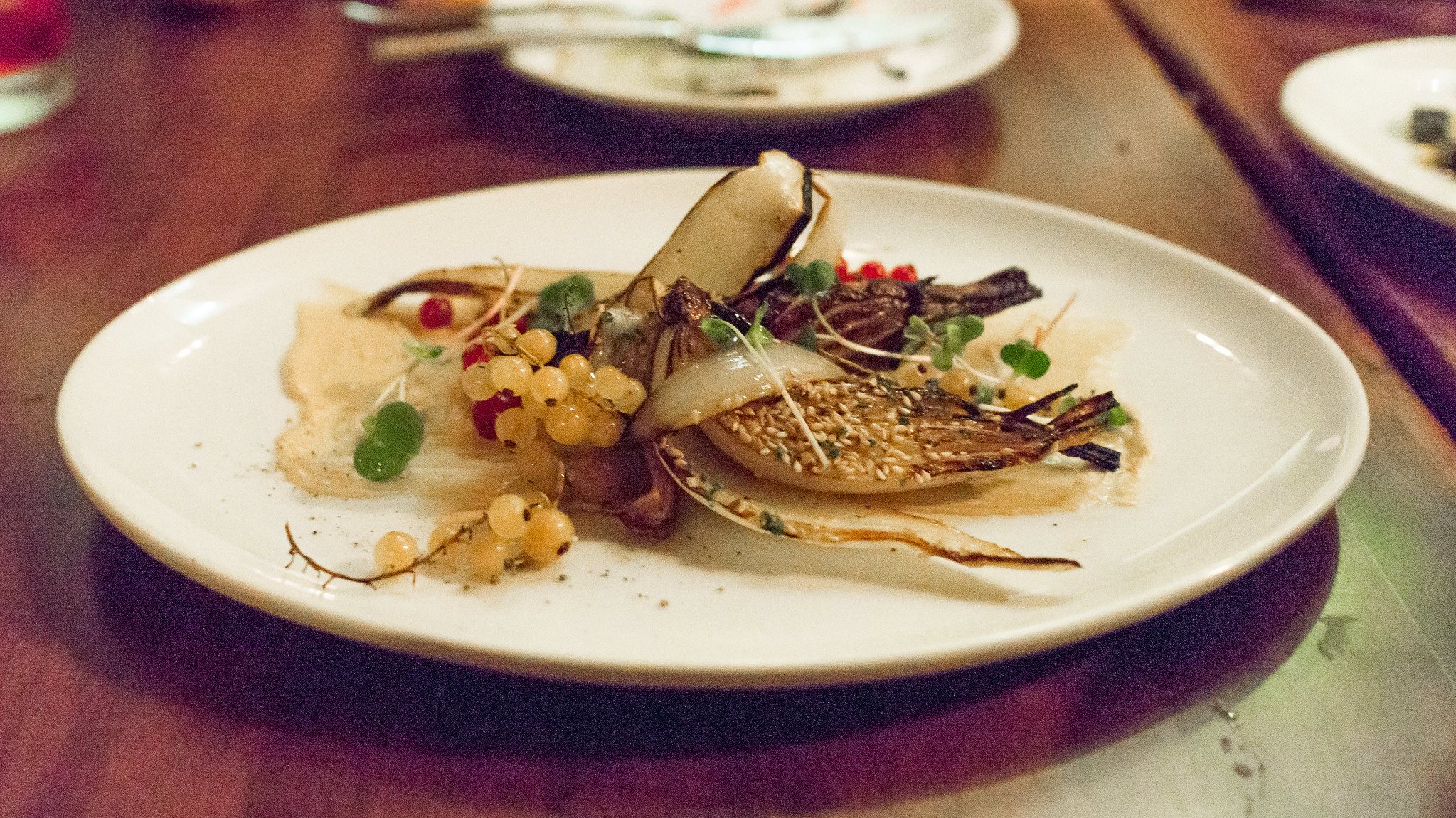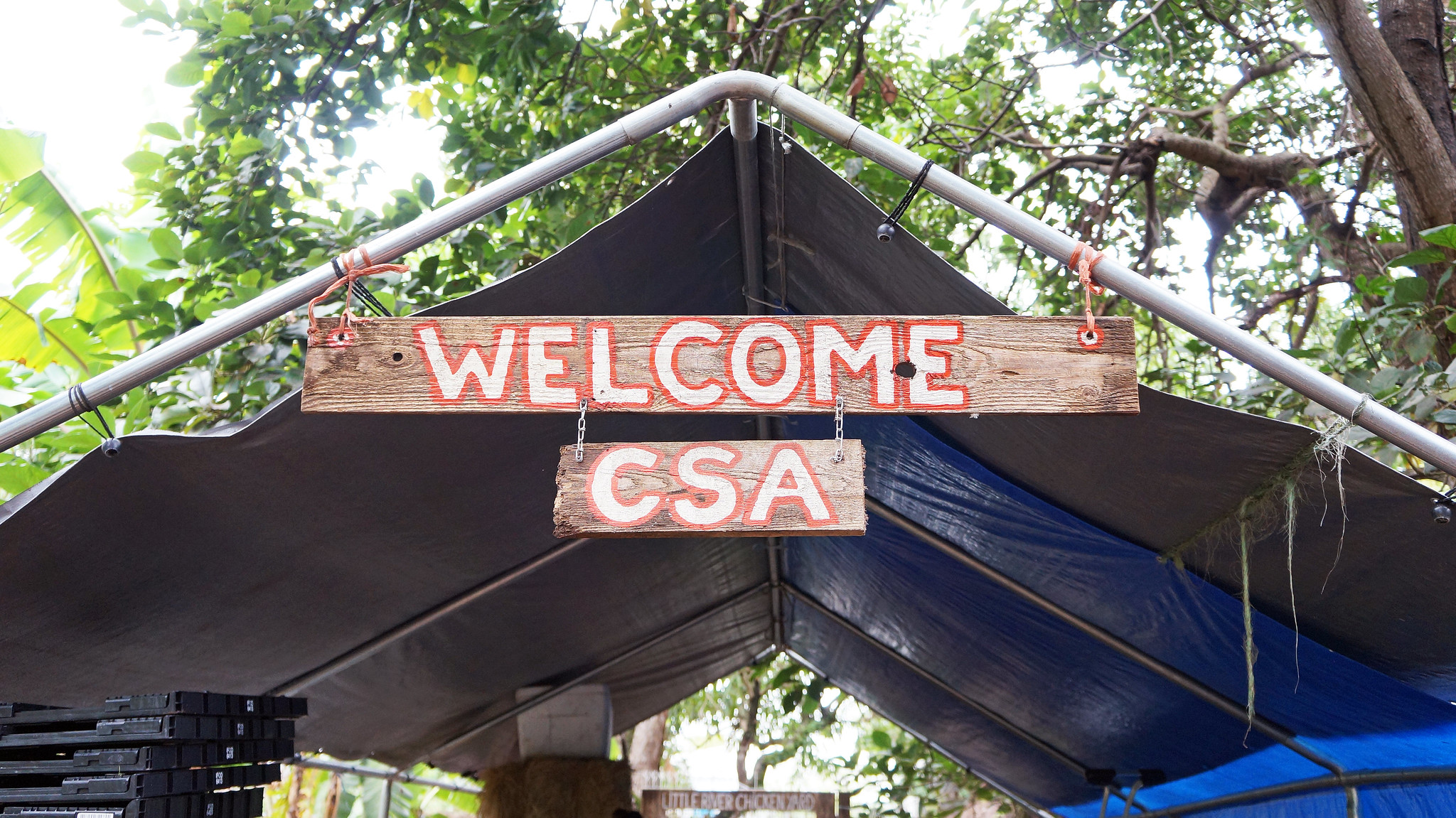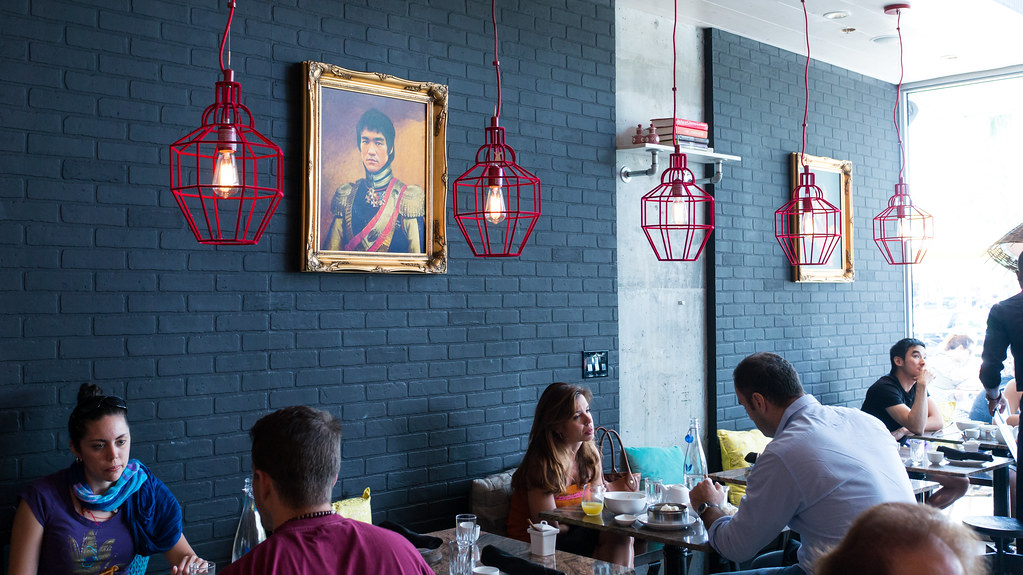Showing posts with label eat your vegetables. Show all posts
Showing posts with label eat your vegetables. Show all posts
Thursday, October 1, 2015
best thing i ate last week: grilled carrots with aged gouda and buckwheat at Eating House
Somehow, I had let a year go by since my last visit to Eating House, Giorgio Rapicavoli's pop-up gone permanent on the northern edge of Coral Gables. That was dumb of me. This past weekend I grabbed a solo spot at the bar after both wife and daughter had abandoned me for the evening, and sampled as much as I could of the current menu. Some staples remain: the tomatoes with coconut ice and Vietnamese flavors, the chicken and "foi-ffles," the over-the-top pasta carbonara. But everything else around the edges is new – and very good.
Vegetable-focused dishes in particular are a strong suit, and of these, my favorite was a plate of grilled carrots, blanketed in soft curls of a powerfully rich five-year aged gouda cheese (it gets crystals like a good aged parmigiano-reggiano), dappled with crunchy buckwheat kernels, all resting atop a pillow of a creamy carrot-top pesto. I especially liked that the carrots were not annihilated, but maintained a not-quite-raw but still firm core – so you get both clean, vegetal snap and dark, sweet roasty caramel flavors. It was the best thing I ate last week.
Runners-up: the blistered shishito peppers showered with cured egg yolk and dry olive at Eating House; the flaky malawach bread (a Yemenite specialty) served with spicy hariff, grated tomatoes, feta cheese and hard boiled egg for brunch at 27 Restaurant (especially good when accompanied by a Miso Honey Cold Brew).
Tuesday, September 8, 2015
Coi - San Francisco
There's a passage in Daniel Patterson's book "Coi: Stories and Recipes" that I found almost painfully evocative. The chef was writing about his first restaurant in Sonoma, and the turning of the season from summer to fall:
It was when the rains came, and the tourists went away. The first year the bills piled up on the mantelpiece at home, one pile per week, carefully bound with a rubber band, the total owed marked on a Post-it on top. At first there were two, then four and later eight piles, sitting there as a constant reminder of our empty dining room. The rain cut off roads and flooded fields, seeping into our subterranean bedroom at home, filling it with the smell of damp concrete and mold. Subsequent years were never as bad as the first, but every fall after that, as the days shortened and our bank account dwindled, my heart broke a little as we dug in for an isolated, depressing winter. That was some time ago, but the scars still remain. Every year, even now, when I step outside and feel that the light has changed, that it is fall and that summer is gone, I fight down a rising panic. It will be all right, I tell myself, over and over, until eventually I believe it enough to keep going.Coi is one of the more unusual "cookbooks" I've read lately. It's not so much the format, which pairs a thoughtful one-page essay with each recipe, nor even the initially somewhat distracting decision to put all the ingredients and quantities for those recipes in a separate index at the back of the book. And while Patterson can wax seriously eloquent about what inspires his dishes and how to cook them, it wasn't entirely that either. What was so striking was his willingness to provide these personal and often brutally candid insights into the fears and frustrations of being a professional chef.
The restaurant business is a weird and particularly tough one that seems to be constantly teetering between success and failure, both on a macro and micro level. In a sea of competition, it's hard enough to figure out what's going to capture the dining audience's interest. Then you actually have to make it work. Even when you do, this year's hot-spot can quickly turn into next year's has-been. Get all the big things right, and you're still only as good as your last plate: some line cook screws up the seasoning or cooking time on one dish, or your server is having a lousy day, and a customer leaves with a bad impression that you may never have a second chance to remedy.
From reading his book and following his career, it's clear Patterson recognizes and, in his own way, embraces this dance on the edge. In the essay about his "beet rose," an almost absurdly labor-intensive dish in which slivers of roasted beet are assembled by hand to resemble the petals of a rose, then paired with an aerated yogurt and rose petal granita, he describes it like this:
When a dish is right, there is synchronicity between form and substance, idea and execution. This is a dish that was meant to be challenging to make, impractical to reproduce. There is something about its unreasonableness which makes it more impactful. For it to work, everything has to be perfect. ... But I came to love it most for what it represented to me: intuitive, handmade cooking. Each rose is a little different, and I can pick out who made which one every night. The seasoning is finely tuned, wobbling on the edge of sweet and savory, always close to tumbling into failure.That sounds a little crazy, but yeah, I'd like to experience that. Because as good a writer as he is, Patterson is pretty universally recognized to be an even better chef. And yet I'd never paid a visit to the restaurant from which the book takes its name. My travels to the West Coast are almost always with family, which means my opportunities to do tasting menus are limited. And other, shinier objects always seemed to beckon. Then a month ago, Patterson announced that he was stepping down as executive chef at Coi and handing over the reigns to chef Matthew Kirkley in January. It was a surprising announcement: first, because Patterson's work at Coi has been so highly regarded, but even more so because it has been so definitively Patterson's restaurant, and his style of cooking is so personal, that the two seemed inseparable.[1]
We already had a trip to San Francisco coming up. So this would likely be the last chance, for the foreseeable future anyway, to catch Patterson in the kitchen. I re-jiggered the agenda, talked the family into doing a tasting menu dinner,[2] and booked a reservation at Coi. When they asked me what kind of restaurant it is, I wasn't sure exactly how to answer. What I knew is that it's a tasting menu format (but much more restrained than the 20+ course bacchanals like Saison); that it's got some locavore / forager sensibilities, but is not wedded to them; and that the cooking uses, but does not seem defined by, contemporary techniques and processes. This undefinability is also something of which Patterson is acutely self-aware:
When it comes to what a marketing wonk would call 'brand clarity,' we don't do ourselves any favors. ... When someone asks, 'What's the food like?' the best thing I can come up with is, 'Um, hopefully delicious,' my voice rising at the end in a note of uncertainty.Well, let's see.
For this farewell tour of sorts, Patterson has seeded the menu with several "greatest hits," and his "California Bowl" is one of those. It's really just an elevated version of chips and dip using some of the basic tropes of California hippie cuisine: brown rice, avocado and sprouts. But those chips (made from rice cooked down to a paste, dehydrated, then fried like chicharrones) are light and airy and have a tingle of spice, the avocado is whipped until soft as a cloud, and zinging with lime, the tiny greens have bright, fresh, intense flavors.
(You can see all my pictures from the dinner in this Coi - San Francisco flickr set).
(continued ...)
Thursday, August 27, 2015
best thing i ate last week (8/2-8/9): celtuce, just dug potatoes, comté, burnt hay, tarragon at Coi
A vacation has taken me off the regular posting cycle, but after two weeks tooling around the Bay Area (including moving Frod Jr. into U.C. Berkeley), I'm home in Miami and ready to get caught up. That means circling back to the first day of our trip: a visit to Coi, which I squeezed into the schedule on account of Chef Daniel Patterson's announcement that he will be stepping down as executive chef in January. (Patterson simultaneously announced that Matthew Kirkley, last at L2O in Chicago, will be taking over the kitchen. In a curious coincidence, I caught Kirkley at L2O only a couple months before it closed last year. That was an excellent meal, and while it's disappointing to see Patterson step away from cooking at Coi, I expect good things are in store.)
(You can see all my pictures from the dinner in this Coi - San Francisco flickr set).
The primary ingredient in this dish is celtuce, featured both in thickly sliced discs and thin ribbons of its stalk. It has the hearty snap of a broccoli stem, and a delicately bittersweet flavor somewhere in the neighborhood of lettuce, celery and asparagus. Freshly dug potatoes are cooked until just tender, and crowned with caps of nutty, buttery melted comté cheese. These sit over an oil blackened with powdered burnt hay. Those black and charred aromas are brought back to green and fresh by a few wispy leaves of tarragon.
"Coi" is an archaic French word meaning "quiet," and Patterson's cooking voice can be quiet, subtle, understated. Sometimes you have to listen closely. If you do so, in this dish maybe you'll hear something that sounds like a field of grass blown by the wind, with all these variations on the vegetal tastes of the pasture.
Runner up: the stone fruit curry with black lime cod, green beans and blueberries at Al's Place, just named the Best New Restaurant of 2015 by Bon Appetit magazine. Like many of chef Aaron London's dishes at Al's Place, the combination of ingredients sounds absolutely implausible, and tastes absolutely delicious.
Wednesday, August 5, 2015
Alter - Miami (Wynwood)
About four years ago I came across a blog called "The Power of a Passion." It was the product of a young chef who had recently moved to Miami after working in Chicago – first a brief tour of duty at Alinea, then a year and a half at L2O during chef Laurent Gras' tenure, followed by a stint as pastry sous chef at Boka, then a move to executive sous chef at Epic. He'd come here to take a position as sous chef at Azul restaurant, where Chef Joel Huff had recently been put in place as executive chef.
The author was Bradley Kilgore. And it may have been those blog posts as much as anything that prompted our interest in doing a Cobaya dinner at Azul – one which ended up being filmed by Andrew Zimmern and featured in an episode of Bizarre Foods. Anyone who was at that dinner – which included at least one course that was Brad's creation – could sense that Kilgore had some real talent.[1]
Several months later we made a return visit to Azul; Huff was gone and the kitchen was now in the hands of Kilgore and chef de cuisine Jacob Anaya. We gave Brad free reign and he put together a sensational meal. His "anatomy of a suckling pig" remains one of the most epic pork-fests I've ever experienced.
Shortly after, Kilgore got an opportunity to run his own spot, and opened Exit 1 in Key Biscayne. But for a lot of reasons that didn't work out. The location was far from ideal, the owners were not exactly veteran operators,[2] and while Brad could cook, he may have been a bit inexperienced himself in all of the other components involved in running a restaurant. That didn't last long, but a better opportunity rolled around when he took over the chef de cuisine position at J&G Grill in Bal Harbour. Here was an established high-end restaurant in the empire of one of the most successful restaurateurs in the world (Jean-Georges Vongerichten), with the bonus of getting to team up with one of Miami's brightest stars: pastry chef Antonio Bachour. Sure, Brad was mostly executing Jean-Georges' best hits, but he also got a little bit of leash to do his own thing too, including some really exceptional on-request tasting menus.
So I was a bit surprised when last November, after a little more than a year at J&G, Kilgore announced that he was leaving to open his own restaurant. As talented as I knew him to be, I'll confess I was concerned that it was too soon. The last thing I wanted – for him, and frankly, for myself as someone who really enjoyed eating his food – was another exit like Exit 1.
I was wrong. He was ready. And his new restaurant – Alter, in Wynwood, which opened in late May – is already one of the best restaurants in Miami.[3]
(You can see all my pictures in this Alter - Miami (Wynwood) flickr set; pictured at top, a pre-dessert of assorted local tropical fruits in a crisp candy shell, served on an inverted woven palm frond basket).
The space, in the burgeoning Wynwood arts district,[4] has a minimalist, industrial feel: the cinder block walls are bare, the ductwork is exposed, the primary decoration is an abstract squiggle of hot pink neon hanging over the liquor shelf that separates the open kitchen from the dining room. The dark-stained wood tables seat about forty, with a small extra seating area outside if the temperatures ever drop. The room can get too warm when it's crowded and too loud when the music's cranked up, both of which are frequent occurrences.
The menu is nearly as spare as the decor. There are usually about eight appetizers and a comparable number of main courses; a five-course tasting menu ($65) is composed from the kitchen's choice of several of those items, some in shrunken-down portions, and is both a solid value and a particularly smart option for a first visit.
Lots of places have fish tartare on their menus these days. Nobody has one like this. Multi-hued batons of green mango and various radishes form a haystack on top of precisely diced fish, the exact species of which is dictated by whatever is local and fresh. There are celery leaves,[5] there's dried soy, there's yuzu kosho, there's black lime zested over the top. It's simultaneously spicy, citrusy, smoky, green, and fresh, as the flavors ping-pong between suggestions of a Thai pok-pok salad and a Peruvian ceviche and other things entirely.
A "signature dish" can be both blessing and curse. It helps define a style – and bring customers in – but can also be a sort of trap, something that can never come off the menu. Alter's soft egg may be its signature dish, and I'm sure it's much too early for Brad to be worried about golden handcuffs.[6] A fluffy, brûléed scallop mousse, bearing just a subtle whiff of the ocean (turn up the volume with an optional dollop of Florida caviar), blankets a runny-yolked, soft-cooked egg hidden within. Also suspended underneath the surface are truffle pearls and a crackly shard of gruyere cheese, like those crusty bits on the side of the bowl that are maybe the best thing about French onion soup.
As signatures go, this is a fitting one for the cooking at Alter. The dish – like much of Brad's work – is a deftly executed balancing act between delicate subtlety and outright indulgence, earth and ocean, creamy and rich without being heavy and cloying. It also displays another thing I see often in Brad's cooking: the incorporation of dessert techniques into savory dishes, what with the mousse and the brûlée, inverting the past decade's trend of incorporating savory elements into desserts. Pro tip: if you're getting the egg, you really also need to get the "bread & beurre," a tender-crumbed miniature loaf crusted with sumac and dill seed, and served with whipped, shoyu-bolstered "umami butter." The bread is delicious on its own, but as a tool for getting every last bit of the egg, it is particularly effective.
Summer squash is often among the most nebbish of vegetables. Not here. Zucchini and yellow squashes are cooked just enough to temper their bitter, raw edge, but not so much as to turn watery and slimy. A green circle of an herbaceous, dill-infused purée serves as the base for their arrangement, which is interspersed with dabs of tart, creamy lemon curd.[7] Crumbles of soft feta cheese, a touch of citron vinaigrette, a tangle of crisp, fresh greens and some crunchy puffed wild rice complete the dish. It works a magical transformation on the squash, like a sexy librarian taking off her glasses and letting down her hair.
(continued ...)
Monday, March 23, 2015
Vagabond Restaurant - Miami MiMo District
When chefs from other cities open restaurants in Miami, there's often a sort of "I'm going to show you how it's done" swagger that locals can find off-putting. You hear lots of broad brush "Miami doesn't have ____" and "Miami doesn't do _____" statements from people who sometimes have spent less than a week here. That limited experience doesn't keep them from professing to educate us all about ourselves and what we're missing.
I was worried we were getting more of the same when I read a pre-opening interview with Alex Chang, the young chef[1] selected to run the Vagabond Restaurant & Bar inside the newly renovated and restored Vagabond Hotel on Biscayne Boulevard.[2] Here's the brash newcomer telling us, "So ... it's different compared to other big cities... I think the food here is not quite as progressive and innovative. I think there's some great chefs here and a lot of people doing some really great stuff, but I think what I found is that there's something missing in the middle to me." And "I just don't think there are restaurants that are super unique here .. like, oh this restaurant bleeds Miami."
At least it was balanced by some humility too: "I'm just trying to really, really figure out what Miami is made of and what it can be..." So I was willing to cut the guy some slack. And if I'm going to be completely honest, though I may not completely agree with the categorical statements, there's an element of truth to what he says.[3] But more important, I wanted to try the guy's food. Let's see what you've got.
(You can see all my pictures in this Vagabond Restaurant flickr set).
There's a "DINER" sign outside the Vagabond Restaurant, keeping with the 1950's era style that's been so faithfully restored throughout the property, and the atmosphere inside is delightfully Jetsons-inspired, staying just this side of kitschy. But Chang's food is decidedly contemporary. Consistent with the "Vagabond" name, inspiration is pulled from all over the map: you'll taste flavors from Mexico, Japan, Italy, Cuba, Thailand, Jamaica, Spain and more – including South Florida. It was interesting to hear from my CSA farmer, Muriel Olivares of Little River Cooperative, that Vagabond has become one of their best customers, and is always interested in the more unusual items they're able to provide. That was a good sign.
(continued ...)
I was worried we were getting more of the same when I read a pre-opening interview with Alex Chang, the young chef[1] selected to run the Vagabond Restaurant & Bar inside the newly renovated and restored Vagabond Hotel on Biscayne Boulevard.[2] Here's the brash newcomer telling us, "So ... it's different compared to other big cities... I think the food here is not quite as progressive and innovative. I think there's some great chefs here and a lot of people doing some really great stuff, but I think what I found is that there's something missing in the middle to me." And "I just don't think there are restaurants that are super unique here .. like, oh this restaurant bleeds Miami."
At least it was balanced by some humility too: "I'm just trying to really, really figure out what Miami is made of and what it can be..." So I was willing to cut the guy some slack. And if I'm going to be completely honest, though I may not completely agree with the categorical statements, there's an element of truth to what he says.[3] But more important, I wanted to try the guy's food. Let's see what you've got.
(You can see all my pictures in this Vagabond Restaurant flickr set).
There's a "DINER" sign outside the Vagabond Restaurant, keeping with the 1950's era style that's been so faithfully restored throughout the property, and the atmosphere inside is delightfully Jetsons-inspired, staying just this side of kitschy. But Chang's food is decidedly contemporary. Consistent with the "Vagabond" name, inspiration is pulled from all over the map: you'll taste flavors from Mexico, Japan, Italy, Cuba, Thailand, Jamaica, Spain and more – including South Florida. It was interesting to hear from my CSA farmer, Muriel Olivares of Little River Cooperative, that Vagabond has become one of their best customers, and is always interested in the more unusual items they're able to provide. That was a good sign.
(continued ...)
Tuesday, March 10, 2015
Saison - San Francisco
There are few meals I've looked forward to with as much anticipation. Between the reports from trusted friends both virtual and flesh and blood, the three Michelin stars conferred late last year (which many thought were overdue), and myriad other raves and recognitions, my expectations for Saison were quite high.
Some reputations are so lofty that I fear the reality cannot possibly compare. But Saison did not disappoint.
Ingredients. Focus. Smoke. Pleasure.
These are the words that keep coming to mind as I look back on our meal.
Ingredients: With a menu that uses primarily seafood and vegetables, prepared in a minimalist style, every item that makes it to the plate has been selected with fanatical attention and care. Many are sourced from nearby: sea urchin from Fort Bragg, seaweeds from Mendocino, vegetables from the restaurant's own farm plot, milk "from our cow."
Focus: Instead of dozens of components thrown together, Saison's dishes have a unity of purpose: nearly every course is about one thing, how to bring out, concentrate, and enhance its flavor. Vegetables are cooked in their own juices, fish are served with sauces infused with their grilled bones, all with the goal of honing and focusing the flavor of the primary ingredient.
Smoke: Almost every dish here is kissed with smoke or fire: grilled over open flame, cooked in the wood-fired hearth, preserved in the smoke that makes its way up the hearth's chimney. This is not just some Luddite counter-reaction to the last decade's increasing focus on kitchen technology. Rather, it's a rediscovery that ancient ways of cooking have powerful ways of highlighting, punctuating, amplifying flavor and texture.
Pleasure: Maybe it's just because these are things that I really like to eat, but Saison's menu feels like it is designed to coddle rather than confront. No doubt, a tremendous amount of thought has gone into the preparation of the dishes; but it doesn't require a lot of thinking to enjoy them.This is not a meal whose purpose is to show you how clever the chef, Joshua Skenes, is. Rather, it's about how much pleasure the diner will take in his work.
(You can see all my pictures in this Saison - San Francisco flickr set).
The pleasure principle kicks in from the moment you enter Saison. There's something delightfully unstuffy about the restaurant. Yes, it's an elegant, beautiful space, filled with live edge wood tables and ornate flower displays; many of the seats are arranged to provide a vantage on a kitchen filled with more gleaming copper than a Mauviel warehouse.[1] But there's also something about it that's very welcoming and even homey: the foyer area is framed by a woodpile, around the corner of which is a cozy little bar where you can start with a cocktail before your meal; that open kitchen feels not so much like a stage with cooks performing for an audience, and more like the open floor plan of a (very rich) friend's loft apartment.
After a pause at the bar, dinner begins with a sort of tea service: an infusion of "some herbs from our garden." Bound with twine, the herbs release a heady aroma as they are dropped into the hot water. The Japanese aesthetic sets the tone for the meal. It's a remarkable thing: there's no dish in particular that is overtly Japanese, but the overall impression is uncannily reminiscent of our meals there last year.[2]
(continued ...)
Some reputations are so lofty that I fear the reality cannot possibly compare. But Saison did not disappoint.
Ingredients. Focus. Smoke. Pleasure.
These are the words that keep coming to mind as I look back on our meal.
Ingredients: With a menu that uses primarily seafood and vegetables, prepared in a minimalist style, every item that makes it to the plate has been selected with fanatical attention and care. Many are sourced from nearby: sea urchin from Fort Bragg, seaweeds from Mendocino, vegetables from the restaurant's own farm plot, milk "from our cow."
Focus: Instead of dozens of components thrown together, Saison's dishes have a unity of purpose: nearly every course is about one thing, how to bring out, concentrate, and enhance its flavor. Vegetables are cooked in their own juices, fish are served with sauces infused with their grilled bones, all with the goal of honing and focusing the flavor of the primary ingredient.
Smoke: Almost every dish here is kissed with smoke or fire: grilled over open flame, cooked in the wood-fired hearth, preserved in the smoke that makes its way up the hearth's chimney. This is not just some Luddite counter-reaction to the last decade's increasing focus on kitchen technology. Rather, it's a rediscovery that ancient ways of cooking have powerful ways of highlighting, punctuating, amplifying flavor and texture.
Pleasure: Maybe it's just because these are things that I really like to eat, but Saison's menu feels like it is designed to coddle rather than confront. No doubt, a tremendous amount of thought has gone into the preparation of the dishes; but it doesn't require a lot of thinking to enjoy them.This is not a meal whose purpose is to show you how clever the chef, Joshua Skenes, is. Rather, it's about how much pleasure the diner will take in his work.
(You can see all my pictures in this Saison - San Francisco flickr set).
The pleasure principle kicks in from the moment you enter Saison. There's something delightfully unstuffy about the restaurant. Yes, it's an elegant, beautiful space, filled with live edge wood tables and ornate flower displays; many of the seats are arranged to provide a vantage on a kitchen filled with more gleaming copper than a Mauviel warehouse.[1] But there's also something about it that's very welcoming and even homey: the foyer area is framed by a woodpile, around the corner of which is a cozy little bar where you can start with a cocktail before your meal; that open kitchen feels not so much like a stage with cooks performing for an audience, and more like the open floor plan of a (very rich) friend's loft apartment.
After a pause at the bar, dinner begins with a sort of tea service: an infusion of "some herbs from our garden." Bound with twine, the herbs release a heady aroma as they are dropped into the hot water. The Japanese aesthetic sets the tone for the meal. It's a remarkable thing: there's no dish in particular that is overtly Japanese, but the overall impression is uncannily reminiscent of our meals there last year.[2]
(continued ...)
Monday, February 23, 2015
Cobaya SoBe with Chefs Andrew Zimmern, Chris Cosentino, Michael Schwartz, Makoto Okuwa and Kaytlin Brakefield
It was more than three years ago that Lee Schrager – grand poobah of the South Beach Wine and Food Festival – joined us as a guest along with Andrew Zimmern for a Cobaya dinner featured on Zimmern's show, Bizarre Foods.[1] A seed was planted then that took a while to germinate, but emerged in full bloom this past Friday.
We nearly did a dinner with the SoBeFest last year, but it didn't quite come together. This time around, all the pieces fell into place: Lee Schrager and the SoBe folks helped round up a great group of chefs and a gorgeous setting (at the Perez Art Museum Miami, which I think is one of Miami's most stunning pieces of architecture), and Andrew Zimmern did double duty as both chef and unofficial curator of the dinner lineup, which included Chris Cosentino (of San Francisco's Cockscomb), local hero Michael Schwartz (of Michael's Genuine), Makoto Okuwa (of Makoto in Bal Harbour, and an alumnus of Cobaya #32), and Kaytlin Brakefield (of Verde restaurant at PAMM). Though we couldn't follow our usual modus operandi of "Here's the date, here's the price, everything else is a surprise," this group put together an outstanding dinner that was still very much in the Cobaya spirit.
(You can see all my pictures in this Cobaya SOBEWFF flickr set).
As guests arrived, each chef had prepared a passed appetizer for a reception in the PAMM lobby: local tuna with puffed wild rice, pickled kohlrabi and tangy "green juice" from Michael Schwartz; sweet Island Creek oysters topped with a smoky, funky n'duja vinaigrette from Chris Cosentino; hamachi crudo with tomato, cucumber and basil from Kaytlin Brakefield; foie gras bonbons with a shiso cake and a neon-bright, cherry-red yamamomo berry glaze from Makoto, a great one-bite wonder; and haystacks of carciofi alla giudia (Jewish style fried artichokes) with a zippy aioli from Andrew Zimmern.
When we first saw a preview menu, I was a bit surprised to see this was Zimmern's chosen dish: the champion of food exotica doing something as pedestrian as fried artichokes? Then I tried them and I understood: crisp, browned petals giving way to that grassy artichoke flavor, cut through by a creamy but high-acid sauce? Sure, I'll have another.
(continued ...)
Wednesday, December 24, 2014
How Does My Garden Grow?
The primary focus here at FFT has always been restaurant dining – but sporadically I've indulged in missives inspired by my CSA subscription with Little River Cooperative, and even the occasional backyard planter box tomato. This October, we plunged in a bit deeper. As part of a landscaping project at the house, we installed a raised vegetable bed in the backyard, and also filled in a defunct little kidney-shaped "pond" with soil and planted it with greens and herbs.[1]
I make no claim to having a green thumb; indeed, if I don't kill a plant within a month I feel like I've accomplished something. But despite my very limited experience, this little garden has been a source of a disproportionate amount of joy the past few months.
We started at the beginning of October with this:
Today, it looks like this:
(You can see all my garden pictures in this flickr set.)
I've been giving something of a weekly play-by-play on Twitter and Instagram, but if you've not been following along there, here's a rough recap of the past few months for Farmer Frod.
The raised bed started with a couple tomato plants, some herbs (mint, basil, sage, lavender, oregano), a couple broccoli plants, and was seeded with radishes and carrots. A couple weeks later I supplemented these with a few more tomatoes (Sungold, Black Krim, Purple Russian, Homestead, and Gold Medal) a zucchini plant (romanesco costata, to be precise), a Tuscan kale, a couple shishito peppers, and a jalapeño, all bought from Little River, The other bed also started with some herbs (chocolate mint, opal basil, a couple different parsleys, tarragon, thyme), a few Swiss chard plants, and was seeded with lettuces, kale and mustard greens.
To give you a good idea of just how much of a novice I am: when these little seedlings started sprouting up a few days later, I called my landscaper in a panic, having no clue whether they were vegetables or weeds.
The radishes and greens came in incredibly quickly, and in a month some were ready to harvest.
(continued ...)
Wednesday, October 1, 2014
Alden & Harlow - Boston
The primary purpose of our trip to Boston actually wasn't eating, but college touring for Frod Jr. Our second day found us in the Boston U. neighborhood around lunchtime, during which we paid a visit to a sweet little Asian food court in the Super 88 Market just west of the campus. There were nearly a dozen different vendors here, and we had perfectly respectable banh mi sandwiches and bowls of pho dac biet from the Pho Viet stall.
Dinner, meanwhile, found us in Cambridge, where we'd made a reservation at Alden & Harlow. I hadn't heard much about the restaurant or the chef, but the unusual, vegetable-centric menu drew me in. (Then shortly after our visit, the restaurant was included in Bon Appetit's "50 Best New Restaurants" list.)
(You can see all my pictures in this Alden & Harlow flickr set).
The ampersand-ed name sounds like a lot of other restaurants that have opened in the past few years, and it looks like a lot of them too: the basement space in Harvard Square is clad in lots of reclaimed wood, subway tile, vintage signs and exposed bulbs. If only more of those places which looked like this had food this good.
One corner of the menu is devoted to "snacks" (a word I find almost irresistibly alluring), all priced at $8 each, while the rest of the menu comprises a couple dozen items, most of which are "share plate" type dishes in the $15 range. A good number of these dishes place vegetables in a feature role.
Frod Jr. can not resist chips and dip, and none of the rest of the family complains when he orders them. Alden & Harlow's "three onion dip" was a really good version, for which I now know the secret, thanks to BA publishing the recipe: a triple-blast of umami from anchovies, mushroom powder and worcestershire sauce. I don't have a recipe, but the appeal of the grilled broccoli served over squash hummus dusted with bianco sardo cheese and crushed cashews isn't so mysterious: it's the great interplay of charred, creamy and crunchy textures.
When was the last time you ate something so good you immediately ordered it again? Not "immediately" as in "the next time you went to the restaurant;" "immediately" as in "while you're still finishing the first order"? That's what we did with Alden & Harlow's seared eggplant with green sauce, sheep's milk cheese, crispy fregola and basil leaves. The eggplant is smoky and almost meaty in texture, the sauce is herbaceous and bright, there's a creamy, briny tang from the cheese, and crunchy contrast from the fried pasta balls. It was one of the best things I've eaten all year.
Many dishes follow the same winning formula, though the particular components differ. Sweet onions are roasted in butter til their edges blacken, paired with an anchovy and tahini crema and sweet-tart white and red currants for contrast. Crispy corn fritters are served over a silky crema, with a summer bean succotash infused with the smoke of Benton's bacon. A similar composition is played by sweet corn gnocchi in a zucchini ragout with crispy serrano ham croutons over the top.
(continued ...)
Dinner, meanwhile, found us in Cambridge, where we'd made a reservation at Alden & Harlow. I hadn't heard much about the restaurant or the chef, but the unusual, vegetable-centric menu drew me in. (Then shortly after our visit, the restaurant was included in Bon Appetit's "50 Best New Restaurants" list.)
(You can see all my pictures in this Alden & Harlow flickr set).
The ampersand-ed name sounds like a lot of other restaurants that have opened in the past few years, and it looks like a lot of them too: the basement space in Harvard Square is clad in lots of reclaimed wood, subway tile, vintage signs and exposed bulbs. If only more of those places which looked like this had food this good.
One corner of the menu is devoted to "snacks" (a word I find almost irresistibly alluring), all priced at $8 each, while the rest of the menu comprises a couple dozen items, most of which are "share plate" type dishes in the $15 range. A good number of these dishes place vegetables in a feature role.
Frod Jr. can not resist chips and dip, and none of the rest of the family complains when he orders them. Alden & Harlow's "three onion dip" was a really good version, for which I now know the secret, thanks to BA publishing the recipe: a triple-blast of umami from anchovies, mushroom powder and worcestershire sauce. I don't have a recipe, but the appeal of the grilled broccoli served over squash hummus dusted with bianco sardo cheese and crushed cashews isn't so mysterious: it's the great interplay of charred, creamy and crunchy textures.
When was the last time you ate something so good you immediately ordered it again? Not "immediately" as in "the next time you went to the restaurant;" "immediately" as in "while you're still finishing the first order"? That's what we did with Alden & Harlow's seared eggplant with green sauce, sheep's milk cheese, crispy fregola and basil leaves. The eggplant is smoky and almost meaty in texture, the sauce is herbaceous and bright, there's a creamy, briny tang from the cheese, and crunchy contrast from the fried pasta balls. It was one of the best things I've eaten all year.
Many dishes follow the same winning formula, though the particular components differ. Sweet onions are roasted in butter til their edges blacken, paired with an anchovy and tahini crema and sweet-tart white and red currants for contrast. Crispy corn fritters are served over a silky crema, with a summer bean succotash infused with the smoke of Benton's bacon. A similar composition is played by sweet corn gnocchi in a zucchini ragout with crispy serrano ham croutons over the top.
(continued ...)
Wednesday, July 23, 2014
Big Things at Little River CSA
For the past few years I've subscribed to a CSA (Community Supported Agriculture) vegetable share through Little River Market Garden, and periodically (OK, sporadically) posted about it here. Muriel Olivares operates a flourishing, but small, "urban farm" from a couple lots in residential neighborhoods in North Miami which produce several dozen varieties of vegetables and fruits. Though it's self-evident from the primary subject matter of this blog that I enjoy dining out, I always get excited when our Fall-Spring South Florida growing season kicks in, and the weekly pickup from farmer Muriel inspires a bit more home cooking.
For this upcoming season there are several new developments of note. First off, there's a new name: Little River Cooperative, as Muriel has partnered with former intern Tiffany Noe to run the farm, CSA and nursery. It's even got a sharp looking new website. The partnership will enable them to add more growing space, which is also going to mean more CSA shares will be available.
Speaking of which, there will now be an option to choose a large share or small share ($640/$500 for 20 weeks of vegetables), and in addition to the regular Saturday pick up location at the Upper East Side Farmers Market at Legion Park (Biscayne & 64th Street), there will also be a new Thursday afternoon pick up location further south at the Grove Green Market in Coconut Grove.
I've talked before about the kinds of things that elevate a food community. There may be none more important than farmers like Muriel and Tiffany who supply fresh local stuff, produced in a natural, sustainable fashion. Though the season doesn't start for a few more months, now is the time to sign up. To do so, or for some more information, go to the Little River Cooperative website.
Sunday, May 4, 2014
BlackBrick (a/k/a Midtown Chinese) - Midtown Miami
"I'm an unpure purist, something like that." - Keith Richards"Authentic" is a word I try to avoid. I'm just not convinced it means an awful lot. Too often, it's thrown about by one-upping blowhards trying to bolster their own credibility ("I spent a weekend in Cabo so I know all about 'authentic' Mexican tacos."). Even for those with more serious intentions, the definition of "authenticity" is elusive, for reasons I've kicked around before. The executive summary: "So many cuisines, even in their 'native' forms, are capable of so many infinite variations, and so many 'traditional' dishes are actually themselves the result of historical cross-cultural mash-ups that would today go by the sobriquet of 'fusion' dishes, that labeling any one particular iteration as 'authentic' is a fool's errand."
"Delicious" is another word I try to avoid. Like "authentic," I'm just not convinced it means much. Unlike "authentic," everyone knows the definition: "this food is good." But it doesn't tell you what is good about it, or why it's good. That unfocused vagueness is why "delicious" is on many food writers' (and editors') lists of banned words.
I'm not going to tell you the food at BlackBrick, Richard Hales' new Chinese restaurant in Midtown Miami, is "authentic." But I will tell you it is "delicious." And I'll do my best to tell you why.[1]
Miami has long been a Chinese food desert. For decades, the Canton chain – a paradigm of mediocrity – somehow managed to be the standard-bearer. Tropical Chinese stands out, but only as a big fish in a little pond. Hakkasan offers a much more refined experience, and their dim sum is excellent, but the price to value (and excitement) ratio of most of the rest of the Hakkasan experience is out of whack. A host of other contenders – Chef Philip Ho, Chu's Kitchen – come and go, with all the stability of Miley Cyrus. Unlike West Coast meccas like Los Angeles, the Bay Area and Vancouver, we seem to lack the populations to support a thriving Chinese restaurant market. And the waves of hyper-regional Chinese restaurants that New York has enjoyed – Sichuan, Shaanxi, Dongbei, Hunan, Yunnan and more, in addition to the more ubiquitous Cantonese – never really made their way here.
(You can see all my pictures in this BlackBrick - Midtown Miami flickr set).
I suspect Richard Hales felt much the same way. And whether because he saw a market opportunity, or just pined to eat better Chinese food and found nobody else making it, he decided to do what he could to change it. BlackBrick, a self-described "passion project," is the result.[2]
Hales' first project as chef/owner was the fast-casual, pan-Asian Sakaya Kitchen, which opened about four years ago. Serving pork buns and Korean chicken wings may not have been an entirely original notion,[3] but Sakaya distinguished itself by focusing on quality ingredients (local and organic whenever possible), fresh preparations, and bold flavors, especially the smoky heat of Korean kochujang that weaves through several dishes.
BlackBrick in some ways follows a similar model, though the service is sit-down style, and the flavor profiles look to China's Sichuan province, among other places, for spicy inspiration. Indeed, if you grab a spot at the counter in front of the open kitchen, you may periodically be inundated by billowing clouds of chili-infused smoke emanating from the wok station.
You can start with something simple and invigorating, like these chicken thighs doused in a spicy chili oil and Chinkiang vinegar, then showered with slivered green onions, cilantro, peanuts and sesame seeds. The poached chicken is served cold with its slippery skin intact, the mild, tender meat a foil for the double dose of spice and sour from the chili oil and black rice vinegar.
"Ma La." These are two more words you're going to want to know. They mean "numbing" and "hot," and their combination – in the form of Sichuan peppercorn (which causes a tingly, numbing sensation) and dried chilies – produces a compulsively tasty, "hurts so good" reaction. It's what makes BlackBrick's "Numbing and Hot Chinese Spare Ribs" so flavorful, the meaty riblets served crusted with dry spice along with wok-sauteed onions, jalapeños and bell peppers.
(continued ...)
Tuesday, February 4, 2014
CSA Weeks 1 through 11 (a/k/a "What Happened to the CSA Posts?")
This is now my third year doing a CSA with Little River Market Garden, and while the quality of the products keeps getting better and better, the frequency of my posting on them has precipitously declined. I managed only two posts all of last season, and here we are halfway through this season, and not a single report yet.
Part of the reason, honestly, is that in our home cooking we mostly sacrifice creativity for simplicity, if not expediency. And while a simple salad or some braised greens may make for good eating, I'm not convinced it makes for exciting reading. Still, it's one of the small highlights of every weekend to pick up my bag of vegetables from Farmer Muriel every Saturday. So here is a glimpse of what I've been doing with it.
Shaved kohlrabi and turnip salad. I think kohlrabi is a vastly underappreciated vegetable. It's got a satisfying snap to its texture and a flavor that reminds of broccoli, but sweeter and less farty. So I was excited to see kohlrabi at Muriel's stand this Saturday,[1] and then even more excited to see a recipe using it from Ignacio Mattos of New York's Estela in the latest edition of Bon Appétit. In fact, it's a dish I had at the restaurant just last month.
This winter salad combines thin-sliced root vegetables (the magazine recipe uses kohlrabi; when I had it at the restaurant, it was with turnip - I used both) and apples, dressed simply with lemon juice, zest, and vinegar, together with fresh mint, nuts (the recipe called for hazelnuts but I had none and used marcona almonds instead) and cheese (I subbed parmesan for the funkier fossa cheese Mattos uses). It's deceptively simple, pretty, and incredibly satisfying: the crunch of the root vegetables, the refreshing tartness of the apples and lemon, the umami from the cheese and nuts, a bright grace note of fresh mint.
Spicy beans and wilted greens. This recipe, with some adaptations, was from last month's Bon Appétit,[2] and brings a motherload of umami via anchovies and parmesan rinds cooked with the beans. We used every green we had in the fridge, which included kale, Swiss chard, turnip greens and kohlrabi greens. Some variation on this theme - greens, beans or a grain, and top it with an egg - is a regular dinner staple in our house.[3]
Backyard tomatoes with burrata, spring onions and arugula. OK, the only thing here that actually came from my weekly CSA share was the onion (and maybe the arugula) - but the tomatoes were from seedlings I bought from Little River at the start of the season. That still counts. I've got about a half-dozen tomato plants going, and the first to bear fruit were the Sungold (a small orange-hued cherry tomato packed with flavor) and the Indigo Rose (almost black-skinned with a bright red interior and a round, sweet flavor). I added one larger grocery store heirloom tomato to bulk this up some. The mint green goddess dressing was inspired by the one served at Ken Oringer and Jamie Bissonette's "Toro Pizzeria" dinner at Harry's Pizzeria last month.
(continued ...)
Part of the reason, honestly, is that in our home cooking we mostly sacrifice creativity for simplicity, if not expediency. And while a simple salad or some braised greens may make for good eating, I'm not convinced it makes for exciting reading. Still, it's one of the small highlights of every weekend to pick up my bag of vegetables from Farmer Muriel every Saturday. So here is a glimpse of what I've been doing with it.
Shaved kohlrabi and turnip salad. I think kohlrabi is a vastly underappreciated vegetable. It's got a satisfying snap to its texture and a flavor that reminds of broccoli, but sweeter and less farty. So I was excited to see kohlrabi at Muriel's stand this Saturday,[1] and then even more excited to see a recipe using it from Ignacio Mattos of New York's Estela in the latest edition of Bon Appétit. In fact, it's a dish I had at the restaurant just last month.
This winter salad combines thin-sliced root vegetables (the magazine recipe uses kohlrabi; when I had it at the restaurant, it was with turnip - I used both) and apples, dressed simply with lemon juice, zest, and vinegar, together with fresh mint, nuts (the recipe called for hazelnuts but I had none and used marcona almonds instead) and cheese (I subbed parmesan for the funkier fossa cheese Mattos uses). It's deceptively simple, pretty, and incredibly satisfying: the crunch of the root vegetables, the refreshing tartness of the apples and lemon, the umami from the cheese and nuts, a bright grace note of fresh mint.
Spicy beans and wilted greens. This recipe, with some adaptations, was from last month's Bon Appétit,[2] and brings a motherload of umami via anchovies and parmesan rinds cooked with the beans. We used every green we had in the fridge, which included kale, Swiss chard, turnip greens and kohlrabi greens. Some variation on this theme - greens, beans or a grain, and top it with an egg - is a regular dinner staple in our house.[3]
Backyard tomatoes with burrata, spring onions and arugula. OK, the only thing here that actually came from my weekly CSA share was the onion (and maybe the arugula) - but the tomatoes were from seedlings I bought from Little River at the start of the season. That still counts. I've got about a half-dozen tomato plants going, and the first to bear fruit were the Sungold (a small orange-hued cherry tomato packed with flavor) and the Indigo Rose (almost black-skinned with a bright red interior and a round, sweet flavor). I added one larger grocery store heirloom tomato to bulk this up some. The mint green goddess dressing was inspired by the one served at Ken Oringer and Jamie Bissonette's "Toro Pizzeria" dinner at Harry's Pizzeria last month.
(continued ...)
Tuesday, November 19, 2013
Willows Inn - Lummi Island, Washington
The first thing I notice upon arriving are the smells: the salt ocean air, fresh cut grass, a whiff of wood smoke. The ferry ride from the mainland takes only about ten minutes, but Lummi Island - the home of the Willows Inn - seems almost a world to itself. Lummi, about a dozen miles from end to end, is the easternmost of the San Juan Islands, an archipelago in the Strait of Juan de Fuca stretching between mainland Washington State and Vancouver Island. It's also one of the more beautiful places I've ever been.
It provided context. And perhaps more than anything else, Chef Blaine Wetzel's cooking is all about context.
The best meals not only nourish and satisfy; they tell a story. It doesn't need to be a complicated one - and indeed, when your mode of communication is a plate of food, it probably can't be. The story of Willows Inn is a simple one, eloquently told: "Here is where you are, right now."
This is the story of Willows Inn, and Lummi Island, on August 15, 2013.[3]
(You can see all my pictures in this Willows Inn flickr set.)
(continued ...)
Subscribe to:
Posts (Atom)


